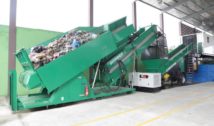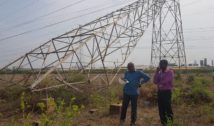Why eating pig’s feet and cow’s stomach can help save the planet
- 10 Apr 2019 --
How often do you eat meat? Once a week? Every day?
If it’s the latter, your diet is having a huge impact on the planet.
You’ve probably heard that the best way to fight climate change is to reduce your meat intake, but if you’re not ready to go full vegan, a new study has found that you can slash polluting emissions by swapping your steak for animal organs.
The meat industry accounts for 14.5% of total global greenhouse gas emissions, more than the transport sector’s direct carbon output.
Despite growing awareness of its negative environmental impacts, we are producing and eating more meat than ever.
But even meat-lovers can help slash emissions by cutting down on meat waste and adopting a “nose to tail” diet, which aims to use every part of the animal.
According to a study published in the Environmental Science and Technology journal, swapping beef ribs and pork chops for offal, internal organs and pig’s trotters could lead to a drastic reduction in emissions.
If 50% less offal was thrown away during the slaughtering process and consumed as food instead, emissions could fall by 14%, according to lead author Professor Gang Liu of the University of Southern Denmark.
There is “huge potential [to lower emissions] by eating more byproducts and reducing waste along the supply chain,” Liu said.
“This way you could use meat more efficiently,” he said, adding that in many Asian countries eating meat byproducts, such as tripe and lungs, is common.
Trevor Gulliver, who co-founded the first nose-to-tail restaurant, St. John, in London, said Western countries “waste horrendous amounts of food with all the potentially catastrophic effects of that.”
“Offal opens up the sense of the whole beast to the Western world, gives greater value to those cuts and brings back greater skills into our kitchens,” he said.


































































































































586 comments
The Confidential
6:31 pmWhat i do not understood is in truth how you are now not really much more smartly-favored than you might be right now. You are very intelligent. You realize therefore significantly in relation to this matter, produced me for my part consider it from a lot of various angles. Its like women and men don’t seem to be involved until it’s something to accomplish with Woman gaga! Your personal stuffs excellent. All the time handle it up!
https://www.zoritolerimol.com
The Confidential
6:31 pmplenty of fish sign in free singles dating search online dating
site personals sites
The Confidential
6:31 pmcustom application essay order essay online cheap can i hire someone to write my
essay the best essay writer
The Confidential
6:31 pmwrite my essay today i need help writing a compare
and contrast essay essays on service can someone write my essay for me
The Confidential
6:31 pmhelp in writing essays buy argumentative essay cheap essay writing
service urgent custom essays
The Confidential
6:31 pmhelp with essay papers will someone write my essay for
me essayhelp custom college essay writing service
The Confidential
6:31 pmhelp with writing an essay college essay writing
help business school essay writing service cheapest essay writing service
The Confidential
6:31 pmhelp writing essays for scholarships need help with essay cheap custom essay papers need help writing a essay
The Confidential
6:31 pmthe best custom essay writing service cheap essays for sale helping
others essay high school essay help
The Confidential
6:31 pmessay writer service review hire someone to write my essay admission essay
editing services essay writing help
The Confidential
6:31 pmcan somebody write my essay lord of the flies essay
help college essay writers block essay write service
The Confidential
6:31 pmhelp for essay writing essay homework help best essay websites essay writer services
The Confidential
6:31 pmbest paper writing site i need help writing
a descriptive essay can t write my essay where can i buy an essay online
The Confidential
6:31 pmcustom essay writing sites best essay writing website custom essay meister cheap essay writing service
The Confidential
6:31 pmcollege application essay editing services help writing essays essay revision help online best cheap essay writing service
The Confidential
6:31 pmessay writing service online best online essay writing service best writing paper essay writers online
The Confidential
6:31 pmcollege application essay services cheapest essay writing service professional custom essays essay writing service discount
The Confidential
6:31 pmessay writing services usa help with argumentative essay customer service essays help writing essays for scholarships
The Confidential
6:31 pm%random_anchor_text% %random_anchor_text% %random_anchor_text% .
The Confidential
6:31 pmfree single dating sites dating sites absolutely free free dating online adult chat dating site
The Confidential
6:31 pmhelp write my essay top rated essay writing services critical essay help essay writing helper
The Confidential
6:31 pmHeya i’m for the first time here. I found this board and I find It truly useful & it helped me out much. I hope to give something back and help others like you helped me.
https://bulktokensender.com/polygon-erc721-nft-bulk-sender-airdrop-tool.html
The Confidential
6:31 pmorder cheap essay online best writing services reviews essay writing service forum can someone write my essay for me
The Confidential
6:31 pmcheap essay writing service online buy essay papers help on college essay best essay writing services
The Confidential
6:31 pmwrite my college essay for me buy essay online for cheap best
college essay editing service what is the best online essay writing service
The Confidential
6:31 pmcustom essays writing help with essay introduction write my essay reviews essay writing help
The Confidential
6:31 pmhelp writing a narrative essay help with college essays essay writing service reviews original essay writing service
The Confidential
6:31 pmneed help in writing an essay i need help writing a essay best online essay writing services essay writer funny
The Confidential
6:31 pmThis is really interesting, You’re a very skilled blogger.
I have joined your rss feed and look forward to seeking
more of your wonderful post. Also, I’ve shared your website in my social
networks!
The Confidential
6:31 pmwindscribe vpn free vpn download for mac pcmag best vpn best vpn for privacy
The Confidential
6:31 pmhow to buy vpn online best vpn for downloading best cheap vpn reddit buy secure vpn
The Confidential
6:31 pmsecureline vpn best vpn service of 2022 wirecutter best vpn best vpn for privacy
The Confidential
6:31 pmbest vpn for chrome free vpn chrome vpn meaning buy vpn with bitcoin
The Confidential
6:31 pmI¦ll right away take hold of your rss feed as I can not to find your e-mail subscription link or e-newsletter service. Do you have any? Kindly allow me recognize in order that I could subscribe. Thanks.
https://playslot77jackpot.win/slot/netent_slot
The Confidential
6:31 pmbest free windows vpn 2017 free vpn google chrome how to set up vpn free internet vpn
The Confidential
6:31 pmHmm is anyone else encountering problems with the images on this blog loading? I’m trying to figure out if its a problem on my end or if it’s the blog. Any feed-back would be greatly appreciated.
https://playslot77jackpot.win/slot/pg_slot
The Confidential
6:31 pmRegards for this wonderful post, I am glad I found this site on yahoo.
https://playslot77jackpot.win/slot/joker_gaming_games
The Confidential
6:31 pmbuy a vpn router express vpn download best vpn services 2019 free vpn list
The Confidential
6:31 pmfree vpn for windows 7 vpn gratuit free vpn for chromebook vpn network
The Confidential
6:31 pmbest free vpn for mobile free vpn best buy vpn uk zenmate free vpn
The Confidential
6:31 pmdownload free vpn for pc best vpn to change location best free vpn for windows best vpn app for windows
The Confidential
6:31 pmopera vpn review zenmate free vpn best mac vpn good free vpn
The Confidential
6:31 pmcasino games online that pay real money bellisbet live casino online casino games online casino gambling
The Confidential
6:31 pmonlinekasino free online games to win real money no deposit top 10 online casino mobile casino games
The Confidential
6:31 pmcasino online real money no deposit online casino usa real money
no deposit paypal games for real money play casino games for real money
The Confidential
6:31 pmmobile casinos best casino deposit bonus zone online casino free games one casino
The Confidential
6:31 pmcasino games free online casinos online casino free signup bonus
no deposit required online gambling casino
The Confidential
6:31 pmtop online real money casinos blackjack online free best online usa casinos online gambling
The Confidential
6:31 pmsan manuel online casino real online casino usa that pays out best online usa casinos play casino games online for money
The Confidential
6:31 pmonline casino real money paypal online casino free bonus no
deposit best real money online casino online casino slots
The Confidential
6:31 pmfree sign up bonus online casino online games that pay real money play casino games online real money no deposit casino
The Confidential
6:31 pmonline gambling sites no deposit free play online casino
play for real money casino casino signup bonus
The Confidential
6:31 pmThis really answered my problem, thank you!
https://surgwinmax3.live/
The Confidential
6:31 pmfree slots/penny vegas live slots hit it rich casino slots diamond slots
The Confidential
6:31 pmclip art gambling slots casino slots online svierge
casino slot machines sale vegas world slots
The Confidential
6:31 pm100% free slots games golden casino free slots play free online slots machine 999999999999 baba wild slots casino facebook
The Confidential
6:31 pmfortnite weapon slots inferno slots login 100% free downloadable slots games ceaser slot free games
The Confidential
6:31 pmwms slots free online best slots to play casino slots
online| slots game
The Confidential
6:31 pmceasars slots caesars free slot casino san manuel casino online scatter slots topless
The Confidential
6:31 pmscatter slots facebook online free slots play slots online free hack online slots
The Confidential
6:31 pmcasino slot machines sale las vegas world free slots
inferno slots casino ceaser free casino slots
The Confidential
6:31 pmAn fascinating discussion is worth comment. I believe that it is best to write extra on this topic, it may not be a taboo subject however usually individuals are not sufficient to speak on such topics. To the next. Cheers
https://playslot77.iadc-online.org/
The Confidential
6:31 pmThanks for sharing. I read many of your blog posts, cool, your blog is very good. https://accounts.binance.com/de-CH/register?ref=WTOZ531Y
The Confidential
6:31 pmwhoah this weblog is fantastic i like studying your posts. Keep up the great paintings! You already know, lots of individuals are searching around for this info, you can help them greatly.
https://fastwin77.keepgooglereader.com/
The Confidential
6:31 pmCarrier oils usually make up 90 of oalen beard oil review oil.
https://suba.me/
The Confidential
6:31 pmYou possess an one of a kind craft. Your creating capabilities are wonderful. Kudos for providing information online and cultivating your visitors.
https://suba.me/
The Confidential
6:31 pmI’m really impressed with your writing skillsas well as with the layout on your blog. Is this apaid theme or did you modify it yourself? Either way keep up the nice quality writing, it’srare to see a great blog like this one these days.
https://www.sokvape.com/randm-tornado-7000/
The Confidential
6:31 pmHey There. I found your blog using msn. This is a very well written article. I’ll be sure to bookmark it and come back to read more of your useful information. Thanks for the post. I’ll definitely return.
https://www.deltakom.net
The Confidential
6:31 pmI value the article post.Really thank you!
https://openprocessing.org/user/390211/?view=sketches
The Confidential
6:31 pmIm grateful for the blog article.Much thanks again. Much obliged.
https://www.plc-wholesale.com/New-sealed-Allen-Bradley-1747-L541-SLC-500-SLC-5-04-CPU-Processor-p170260.html
The Confidential
6:31 pmI really like and appreciate your post.Much thanks again. Fantastic.
https://gregoryvyyxw.mybjjblog.com/top-coimbatore-car-rental-secrets-34436345
The Confidential
6:31 pmThank you for your blog.Really thank you!
https://amritsar-escorts82603.xzblogs.com/61800693/the-smart-trick-of-kamagra-reviews-that-no-one-is-discussing
The Confidential
6:31 pmMuchos Gracias for your post.Really thank you! Much obliged.
https://www.horyou.com/member/dog-trekking/news/x-dog-trekking
The Confidential
6:31 pmI think this is a real great article post.Really looking forward to read more.
https://trevorflpsu.bloggerbags.com/26169923/detailed-notes-on-canada-visa-cost
The Confidential
6:31 pmHello.This article was really remarkable, particularly since I was looking for thoughts on this matter last Sunday.
https://officeblock.io
The Confidential
6:31 pmVery neat article post.Thanks Again. Keep writing.
https://pleval.com/product/long-handle-1-pair/
The Confidential
6:31 pmI really enjoy the blog article.Much thanks again. Really Cool.
https://www.screen-assembly.com/
The Confidential
6:31 pmGreat blog post.Thanks Again. Will read on…
电子烟和香烟哪个比较毒?
The Confidential
6:31 pmI cannot thank you enough for the article.Much thanks again. Will read on…
https://www.guangsuan.com/
The Confidential
6:31 pmThanks again for the post. Will read on…
https://www.hilaud.com/Products/Non-Woven-Bag_09.html
The Confidential
6:31 pmThis is why today in Overfly we will cover all you need to have to know about what is a paraglider speed bar and how does it function.
https://www.gmbreviews.net/
The Confidential
6:31 pmThanks for the good writeup. It in fact used to be a enjoyment account it.Glance advanced to more introduced agreeable from you! By the way, howcan we be in contact?
https://odata.fr/
The Confidential
6:31 pmEnjoyed every bit of your blog post.Thanks Again. Cool.
https://www.lastingsafe.com/vault-door
The Confidential
6:31 pmI value the article post. Really Cool.
https://wheyprotein38271.dreamyblogs.com/2495517/everything-about-masala-traders
The Confidential
6:31 pmEnjoyed every bit of your blog.
https://net7797395.blogvivi.com/21995534/rumored-buzz-on-birla-alokya-location
The Confidential
6:31 pmGreat post. Really Cool.
https://nutrition94948.timeblog.net/56914182/jaipur-to-ranthambore-one-day-tour-package-an-overview
The Confidential
6:31 pmI value the blog article.Thanks Again. Will read on…
https://whey-protein63838.bloggerswise.com/26856443/not-known-factual-statements-about-apply-canada-visa
The Confidential
6:31 pmEnjoyed every bit of your article post.
http://riosabeloco.com/User-Profile/userId/191531
The Confidential
6:31 pmVery good blog post.Really thank you! Much obliged.
https://artmight.com/user/profile/2253989
The Confidential
6:31 pmI loved your blog post.Really looking forward to read more. Great.
https://meatking.hk/
The Confidential
6:31 pmThanks so much for the article.Really looking forward to read more. Keep writing.
https://www.creatingway.com/how-to-do-polishing-titanium-machining-parts-stepwise/
The Confidential
6:31 pmI cannot thank you enough for the post.Much thanks again. Want more.
https://learncswithus.com/2022/07/15/alpha-studio-website-for-writing-essays/
The Confidential
6:31 pmWonderful blog! I found it while browsing on Yahoo News. Do you have any suggestions on how to get listed in Yahoo News? I’ve been trying for a while but I never seem to get there! Appreciate it
https://soyroll09.bloggersdelight.dk/2023/09/09/upgrade-viettel-home-network-functionality-top-tips-enclosed/
The Confidential
6:31 pmivermectin lotion for lice equine ivermectin paste
https://telegra.ph/Boost-Viettel-Home-Wi-Fi-Performance-Best-Guidelines-Enclosed-09-09
The Confidential
6:31 pmThese are truly great ideas in regarding blogging. Youhave touched some fastidious things here. Any way keep up wrinting.
https://courses.9marks.org/members/locustbelt85/activity/482733/
The Confidential
6:31 pmIt’s actually a great and useful piece of info. I am happy that you just shared this useful info with us.Please keep us up to date like this. Thank you for sharing.
https://courses.9marks.org/members/locustbelt85/activity/482733/
The Confidential
6:31 pmHeya are using WordPress for your blog platform?I’m new to the blog world but I’m trying to get started and create my own. Do you require anyhtml coding expertise to make your own blog? Any help would be really appreciated!
https://damoaberry.com
The Confidential
6:31 pmrobux hack generator no human verification
https://damoaberry.com
The Confidential
6:31 pmThanks for sharing, this is a fantastic blog.Really looking forward to read more. Keep writing.
https://bnhealthy.com/
The Confidential
6:31 pmHey, thanks for the blog article.Thanks Again. Really Great.
https://wheyprotein38272.eedblog.com/21708596/new-step-by-step-map-for-masala-wholesale-market-in-mumbai
The Confidential
6:31 pmThanks a lot for the post.Much thanks again. Keep writing.
https://kuafotiyu.com
The Confidential
6:31 pmThanks-a-mundo for the post. Will read on…
https://www.irontechdoll.com
The Confidential
6:31 pmSpot on with this write-up, I honestly think this web site
needs far more attention. I’ll probably be back again to read through more, thanks for the info!
The Confidential
6:31 pmUndeniably believe that which you said. Your favorite reason seemed
to be on the internet the simplest thing to be aware of.
I say to you, I definitely get annoyed while people think about worries that they plainly don’t
know about. You managed to hit the nail upon the top and also defined out the whole thing without having side effect , people could take a
signal. Will probably be back to get more. Thanks
The Confidential
6:31 pmAhaa, its nice conversation about this article at this place at this blog, I have read all that, so at this time me also commenting here.
https://pasionmonumental.com/se-agranda-la-capacidad-en-el-mas-monumental-antes-de-lo-previsto-la-autorizacion-que-pidio-river-para-el-partido-contra-talleres/
The Confidential
6:31 pmAfter I initially left a comment I appear to have clicked on the -Notify
me when new comments are added- checkbox and now whenever a comment is added I receive 4
emails with the exact same comment. Perhaps there is an easy method you can remove me from that service?
Cheers!
The Confidential
6:31 pmVery energetic post, I liked that bit. Will there be a part 2?
The Confidential
6:31 pmThis blog was… how do you say it? Relevant!! Finally I’ve found something that helped me.Thanks a lot!Also visit my blog post: Clinical Keto Diet
https://www.myapnet.org/business-directory-2/3088/liberians-in-columbus-inc-lici/
The Confidential
6:31 pmIt’s really very complex in this busy life to listen news on TV, thus I only use world wide web for that reason, and
get the latest news.
The Confidential
6:31 pmGood way of explaining, and fastidious article to take facts on the topic
of my presentation subject, which i am going to
deliver in college.
The Confidential
6:31 pmSince the admin of this site is working, no doubt very soon it will be
well-known, due to its quality contents.
The Confidential
6:31 pmI’m not sure where you are getting your info, but good topic.I needs to spend some time learning much more or understanding more.Thanks for wonderful info I was looking for this information for my mission.
http://www.tarancutaurbana.ro/galati-orasul-cu-aerul-cel-mai-curat-din-romania/
The Confidential
6:31 pmI am regular reader, how are you everybody? This post posted
at this website is actually nice.
The Confidential
6:31 pmWow, incredible blog layout! How long have you been blogging for?
you make blogging look easy. The overall look of your web site is wonderful, as well as the
content!
The Confidential
6:31 pmI really liked your blog article.Really thank you!
https://juliusrxadf.sharebyblog.com/20983517/the-fact-about-d3-js-development-company-that-no-one-is-suggesting
The Confidential
6:31 pmI got this website from my pal who shared with me regarding this
web site and now this time I am visiting this web site and
reading very informative articles or reviews here.
The Confidential
6:31 pmThank you for sharing your thoughts. I really appreciate your efforts and I will be
waiting for your further post thank you once again.
The Confidential
6:31 pmYes! Finally something about 출장.
The Confidential
6:31 pmI cannot thank you enough for the blog post.Much thanks again. Really Cool.
https://wholesalenutrition05049.kylieblog.com/24871396/the-single-best-strategy-to-use-for-chidiya-tapu-island
The Confidential
6:31 pmFor latest news you have to pay a visit the web and on web I found this
web site as a best web page for most recent updates.
The Confidential
6:31 pmI really love your website.. Excellent colors & theme.
Did you create this website yourself? Please reply back as I’m hoping to create my very own blog and would love to find out where
you got this from or just what the theme is called.
Appreciate it!
my web blog: https://katalog-stron-internetowych.eu/
The Confidential
6:31 pmSpot on with this write-up, I really think this amazing site needs a lot more attention. I’ll probably be back
again to read more, thanks for the information!
The Confidential
6:31 pmThanks so much for the blog.Much thanks again. Much obliged.
https://alexisllhf061627.win-blog.com/25576734/the-single-best-strategy-to-use-for-online-ielts-coaching
The Confidential
6:31 pmIm grateful for the blog post.Really thank you! Fantastic.
https://net7706924.bloggosite.com/27597083/considerations-to-know-about-satta-dpboss
The Confidential
6:31 pmWe’re a bunch of volunteers and starting a brand new scheme in our community.
Your site provided us with helpful information to work on. You have performed a formidable activity and our whole
community will be grateful to you.
The Confidential
6:31 pmI believe that is among the such a lot significant information for me.
And i am happy studying your article. But wanna commentary on some common things, The
web site taste is wonderful, the articles is really
nice : D. Good activity, cheers
Also visit my site … www
The Confidential
6:31 pmWow, great blog post.Much thanks again. Really Cool.
https://slides.com/sony1122
The Confidential
6:31 pmIt is appropriate time to make some plans for the long run and it is time to be happy.
I’ve read this submit and if I may I desire
to counsel you few interesting things or suggestions. Maybe you
could write subsequent articles relating to this
article. I desire to learn even more issues about
it!
my web-site :: slot deposit pulsa Indosat
The Confidential
6:31 pmLooking forward to reading more. Great blog post.Really looking forward to read more. Cool.
https://gunnerbmpuw.blogspothub.com/23731579/5-simple-techniques-for-call-taxi
The Confidential
6:31 pmI want to to thank you for this fantastic read!!I absolutely loved every little bit of it. I have you saved as a favorite tocheck out new things you post…
https://blogfreely.net/nancyskirt53/tips-on-how-to-create-you-soul-searchers-listening-collection-spiritual
The Confidential
6:31 pmI appreciate you sharing this blog article.Thanks Again. Much obliged.
http://lronhubbard.bloggportalen.se/BlogPortal/view/ReportBlog?id=211942
The Confidential
6:31 pmThanks for the article. Awesome.
https://participa.vilanova.cat/profiles/Aman12341/activity
The Confidential
6:31 pmHi there i am kavin, its my first time to commenting anywhere, when i read this piece of writing i thought i couldalso make comment due to this good article.
https://www.youtube.com/@vidathespineclinic
The Confidential
6:31 pmIm grateful for the post.Really looking forward to read more. Will read on…
https://nutrition62726.blogitright.com/22393718/about-ss-nut-manufacturer
The Confidential
6:31 pmwow, awesome blog post.Much thanks again.
https://www.redcuprebellion.com/users/GoldenTriangleBycar
The Confidential
6:31 pmHi there mates, nice post and good urging commented at this place, I
am really enjoying by these. camisetas de futbol
The Confidential
6:31 pmThank you for the auspicious writeup. It in fact was a amusement account it.
Look advanced to far added agreeable from you! By the way, how can we communicate?
The Confidential
6:31 pmWhat’s up friends, fastidious post and pleasant urging commented at this place, I am actually enjoying
by these.
The Confidential
6:31 pmI constantly emailed this web site post page to
all my associates, for the reason that if like to read it afterward
my contacts will too.
The Confidential
6:31 pmIm thankful for the article.Really thank you! Much obliged.
https://www.josenart.com/collections/modern-contemporary-bath-lighting
The Confidential
6:31 pmPiece of writing writing is also a excitement, if you be familiar with then you can write
if not it is difficult to write.
The Confidential
6:31 pmDefinitely believe that which you said. Your favorite
justification seemed to be on the internet the simplest thing to be aware of.
I say to you, I certainly get irked while people think about
worries that they just do not know about. You managed to hit
the nail upon the top and defined out the whole thing without having side
effect , people can take a signal. Will likely be back to get
more. Thanks
The Confidential
6:31 pmI value the article post. Want more.
https://www.hdconnectorstore.com/productdetail/248.html
The Confidential
6:31 pmSay, you got a nice blog post.Really looking forward to read more. Cool.
https://www.fmcncmachining.com{China
The Confidential
6:31 pmNow I am going away to do my breakfast, afterward having my breakfast coming again to read further news.
Athletic Club
The Confidential
6:31 pmI am actually grateful to the holder of this website who has shared this impressive piece of writing at at this place.
The Confidential
6:31 pmivermectin and alcohol ivermectin collies
http://mamochka.ukrbb.net/viewtopic.php?f=22&t=96&p=6086#p6086
The Confidential
6:31 pmWonderful blog! I found it while surfing around on Yahoo News.
Do you have any suggestions on how to get listed in Yahoo News?
I’ve been trying for a while but I never seem to get there!
Thank you
Take a look at my blog post :: http://superpremium2.premium4best.eu/
The Confidential
6:31 pmThanks for finally talking about > Why eating pig's feet
and cow's stomach can help save the planet < Liked it!
The Confidential
6:31 pmLooking forward to reading more. Great blog article.Much thanks again. Really Cool.
https://hlj.fun
The Confidential
6:31 pmA person essentially assist to make significantly articles I might state.
This is the very first time I frequented your website page and to this point?
I amazed with the research you made to make this actual
put up incredible. Fantastic task!
The Confidential
6:31 pmThanks for finally writing about > Why eating pig's feet and cow's stomach
can help save the planet < Liked it!
The Confidential
6:31 pmToday, I went to the beach front with my children. I found a
sea shell and gave it to my 4 year old daughter and said “You can hear the ocean if you put this to your ear.” She placed the shell to her ear and screamed.
There was a hermit crab inside and it pinched her ear. She never wants to go back!
LoL I know this is totally off topic but I had to tell someone!
camisetas de futbol
The Confidential
6:31 pmIf some one needs expert view concerning blogging and site-building then i suggest
him/her to pay a visit this blog, Keep up the nice
work.
The Confidential
6:31 pmIt’s actually a cool and useful piece of info.
I’m happy that you simply shared this helpful info with us.
Please keep us up to date like this. Thanks for sharing.
The Confidential
6:31 pmI think this is among the most vital information for me.
And i am glad reading your article. But wanna remark on few general things, The web site style
is ideal, the articles is really excellent :
D. Good job, cheers
The Confidential
6:31 pmIn fact no matter if someone doesn’t understand afterward its up to
other viewers that they will assist, so here it occurs.
comprar camisetas de fútbol baratas
The Confidential
6:31 pmI always emailed this webpage post page to all my contacts, as if like to read it
afterward my links will too.
The Confidential
6:31 pmI visited multiple blogs but the audio feature for audio songs current at this website is really wonderful.
Camisetas de la Almería
The Confidential
6:31 pmHello! I could have sworn I’ve visited this web site before but after browsing through a
few of the posts I realized it’s new to me. Nonetheless, I’m definitely happy I found it and I’ll be book-marking it and checking back often!
The Confidential
6:31 pmDer Unterschied zwischen der GMT Master Linie und den ursprünglichen Rolex Linien fake uhren ist der GMT Zeiger,der zweite.
The Confidential
6:31 pmA round of applause for your article.Thanks Again. Really Great.
https://www.seppeschina.com/
The Confidential
6:31 pmI cannot thank you enough for the blog post.Really looking forward to read more. Much obliged.
https://www.daikaizhengming.com/
The Confidential
6:31 pmThanks again for the blog.Much thanks again. Want more.
https://www.chemistry-labfurniture.com
The Confidential
6:31 pmHi this is kinda of off topic but I was wondering if blogs use WYSIWYG editors or if you have to manually
code with HTML. I’m starting a blog soon but have no coding
expertise so I wanted to get guidance from
someone with experience. Any help would be enormously appreciated!
Here is my web page :: http://test2.premium4best.eu/
The Confidential
6:31 pmIt’s an awesome piece of writing for all the web visitors;
they will obtain advantage from it I am sure.
my blog :: www
The Confidential
6:31 pmHi every one, here every one is sharing these familiarity,
so it’s good to read this blog, and I used to visit this webpage
all the time.
The Confidential
6:31 pmI am extremely impressed with your writing skills and also with the layout on your weblog.
Is this a paid theme or did you modify it yourself? Either
way keep up the excellent quality writing, it’s
rare to see a nice blog like this one nowadays.
The Confidential
6:31 pmYou are so awesome! I do not believe I’ve read anything like that before.
So wonderful to find somebody with a few genuine
thoughts on this topic. Really.. many thanks for starting this up.
This web site is something that is required on the web, someone with some originality!
camisetas de futbol
The Confidential
6:31 pmWow, that’s what I was exploring for, what a stuff! present here at this webpage, thanks admin of this web site.
The Confidential
6:31 pmMy family members every time say that I am killing my time here at
web, except I know I am getting familiarity all the time by reading such fastidious
posts.
The Confidential
6:31 pmIf you wish for to improve your knowledge only keep visiting this web page
and be updated with the latest news update
posted here.
The Confidential
6:31 pmNormally I do not learn article on blogs, but
I would like to say that this write-up very forced me to take a look at and do it!
Your writing taste has been amazed me. Thanks, very
great post. camisetas de futbol
The Confidential
6:31 pmI am extremely impressed with your writing skills and also with the layout on your weblog.
Is this a paid theme or did you modify it yourself?
Either way keep up the nice quality writing, it’s rare to see a great blog like this one today.
The Confidential
6:31 pmFantastic blog.Much thanks again. Much obliged.
https://bonito-packaging.com/
The Confidential
6:31 pmThank you for the auspicious writeup. It in fact was a amusement account it.
Look advanced to more added agreeable from you!
However, how can we communicate?
The Confidential
6:31 pmReally when someone doesn’t be aware of afterward its up to other users that theywill assist, so here it happens.
https://advance-esthetic.us/clearfx-skin-1000-microdermabrasion-machine-for-sale
The Confidential
6:31 pmWhat’s up Dear, are you truly visiting this site
regularly, if so then you will definitely obtain nice experience.
The Confidential
6:31 pmSaved as a favorite, I love your site!
The Confidential
6:31 pmFantastic post.Thanks Again. Want more.
https://pre-workout61605.collectblogs.com/66357485/5-simple-statements-about-senior-citizens-chardham-yatra-explained
The Confidential
6:31 pmI¡¦m not sure the place you’re getting your information, however good topic. I must spend a while finding out much more or figuring out more. Thanks for fantastic information I was searching for this info for my mission.
https://goldlibertycoins.com
The Confidential
6:31 pmHi, its pleasant article oon tthe tpic oof media print, wee
aall know media iss a wonderful source off data.
The Confidential
6:31 pmDefinitely believe that which you said. Your favorite reason appeared to be on the web the simplest thing
to be aware of. I say to you, I certainly get annoyed while people
consider worries that they just don’t know about. You
managed to hit the nail upon the top and also defined out the whole thing without having side-effects ,
people could take a signal. Will likely be back to get more.
Thanks
The Confidential
6:31 pmI all the time emailed this webpage post page to all my associates, as if like to read it then my friends will too.
Feel free to visit my webpage Soft LED Mesh Curtain (Sebastian)
The Confidential
6:31 pmFantastic beat ! I wish to apprentice while you amend your website, how could i subscribe
for a blog web site? The account helped me a acceptable deal.
I had been a little bit acquainted of this your broadcast provided bright clear idea
The Confidential
6:31 pmexcellent submit, very informative. I wonder why the opposite
experts of this sector do not understand this. You must continue your writing.
I am confident, you have a great readers’ base
already!
The Confidential
6:31 pmHey there! I’ve been reading your weblog for a long time
now and finally got the courage to go ahead and give you a shout out from
New Caney Texas! Just wanted to mention keep up the fantastic work!
The Confidential
6:31 pmExcellent weblog right here! Also your website rather a lot up very fast!
What host are you using? Can I get your associate hyperlink for your host?
I want my website loaded up as quickly as yours lol
The Confidential
6:31 pmWe’re a group of volunteers and starting a new scheme in our
community. Your website offered us with valuable info to work on. You’ve done a formidable job and our entire community will be
grateful to you.
The Confidential
6:31 pmHi there it’s me, I am also visiting this web page daily,
this web page is genuinely good and the people are in fact sharing good thoughts.
The Confidential
6:31 pmHello there, just became alert to your blog through Google,
and found that it’s truly informative. I am going to watch
out for brussels. I’ll appreciate if you continue this in future.
Many people will be benefited from your writing. Cheers!
The Confidential
6:31 pmWow, marvelous blog layout! How long have you been running a blog for?
you make blogging glance easy. The whole glance of your website
is wonderful, as smartly as the content!
The Confidential
6:31 pmI was recommended this website by my cousin. I am not
sure whether this post is written by him as nobody
else know such detailed about my trouble. You’re wonderful!
Thanks!
The Confidential
6:31 pmI have been browsing online more than three hours these days,
but I by no means discovered any fascinating article like
yours. It’s beautiful worth enough for me. In my view, if all website owners and
bloggers made good content as you probably did,
the internet can be a lot more useful than ever before.
The Confidential
6:31 pmWe stumbled over here different page and thought I might check
things out. I like what I see so now i am following you.
Look forward to checking out your web page for a second
time.
Here is my web blog – https://baza-firm-online.eu/
The Confidential
6:31 pmHi there, I want to subscribe for this weblog to take newest updates, therefore where
can i do it please help.
The Confidential
6:31 pmI’ll right away grasp your rss as I can’t in finding your e-mail
subscription link or newsletter service. Do you’ve any? Kindly let me understand so that I could subscribe.
Thanks.
The Confidential
6:31 pmgeneric cephalexin: order amoxil onlineorder flagyl
https://is.gd/zoOg3z
The Confidential
6:31 pmwhoah this blog is wonderful i really like studying your posts.Stay uup thee goodd work! You recognize, a lot of people are searching round for this information,you can help them greatly.
http://beetlees.pro/story.php?id=394
The Confidential
6:31 pmVery good article post.Much thanks again. Keep writing.
https://magicmushroomchocolatebars.co.uk/product/trippy-treats-mushroom-chocolate-bar/
The Confidential
6:31 pmDOLLMAIDリアルシリコンドールは高度的な自然、人に信じられる見た目を備えます。シリコンラブドールはもっと真実に感じられて、リアルな人間を驚くほど似たような質感があります。つまり、シリコンはセックスドールの完璧な材質です,リアルで生き生きとした、人に満足できるセックスドールを探す方はシリコンドールの注文を検討する必要があります。
The Confidential
6:31 pmKumpulan Nama-Nama Daftar Situus Judi Slott Online Terpercaya dan Prvider
Slot88 Slot Gacor Terbaru di 2021
Masih mencai kumpulan daftr laman judi slot onlinbe terpercaya yang fair play?
Sekian banyak bandar sloit online yag bertebaran di duna mayha pasti mebikin anda kebingungan, maqna
lamn judi slkot online bnafit dan maana yan tidak bonafit bagi para pemain. Permainan slokt
online betul-betul popluler dan disukai oleh kalajgan masyarakat Indonesia lebih-lebih ddi kota-kota besar.
Apalai diala menghadapi pandemi yanhg ttak unjung habiss ini, oeang
– orang berbondong-bondong mencarri situys judi sloot nline terppercaya 2022 utuk mengisi waktu luangnya.
Kumpuylan dari nama-nama daftar sot online bertebaran melewati dunia maya.
Untuk merregistrasikan diri, anda bissa menjalankkan peencarian via google, rujukan teeman ataaupun dar social medi berupa Facebook, Istagram daan Twitter.
Ragam gwme slot legl dan original bijsa anda temu llewat mahkotaslot sebagai web judi slot
onlikne terkini 2021. Web slot nline uqng absah biasanya menaarkan gamme judri online lainnya yang tak keok menarik,
variasi-tipe game judsi online lzinnya akan kami bahas pada sesi selanjutnya.
Sebaga ssorang penggemar gamme slot onnline gacor yang ada
dii Indonesia, mungkjin anea ttelah takk asing tentang permainan slot serta provider slot onine yaang kami sediakan. Malahan, anda
mungkin teah mendawfarkan diri dii laman lain tapi merasa kurang
nyaman bagus darii segi pelayanan maupun dari sdgi kemenanban yang diperoleh.
Adaa sebagfian situs judi slot online familiar dan pophler
dan kammi di sini hadirr membgerikan anjuuran permjainan website judi sloot online gackr slot88 ternama dengan deretan keuuntungan daalam
hal bopnus jackpott slot yanng gampang menang.
Kemudahan yang dipsroleh karena perkembangan teknologi adalah anda bisa memainkannya dirumah, kantor, ataipun daerzh nongkrong bermodalkan telepon seluler sertta dunia maya saja.
Stopp by mmy homepage: agen slot gacor
The Confidential
6:31 pmHey There. I found your blog using msn. This is a really well written article.
I’ll be sure to bookmark it and come back to read
more of your useful information. Thanks for the post.
I’ll definitely comeback.
The Confidential
6:31 pmYou need to take part in a contest for one of the greatest blogs online.
I am going to highly recommend this web site!
The Confidential
6:31 pmRemarkable issues here. I am very glad to see your post.
Thanks so much and I am taking a look forward to touch you.
Will you kindly drop me a mail?
The Confidential
6:31 pmMy spouse and I absolutely love your blog and find nearly all
of your post’s to be just what I’m looking for. Would
you offer guest writers to write content for yourself?
I wouldn’t mind publishing a post or elaborating on a number of the subjects you write
about here. Again, awesome website!
The Confidential
6:31 pmIf you are going for most excellent contents like myself, just go to see this
website everyday for the reason that it presents feature contents, thanks
The Confidential
6:31 pmIf you desire to get cars and truck financing online, you need to shorten all the possible bargains and also
prices that suit your spending plan. As typically with the scenario of several,
they have a tendency to neglect the usefulness of contrasting
finance quotes that they tend to spend three times as high as they might have really
saved, get more info.
The Confidential
6:31 pmWish to add even more bacteria combating power throughout the
day?
The Confidential
6:31 pmHello to every one, since I am in fact keen of reading this website’s post to be updated on a regular basis.
It consists of pleasant data.
The Confidential
6:31 pmwhoah this blog is fantastic i love reading your articles.
https://www.siatex.com/promotional-t-shirt-suppliers-manufacturers-in-bangladesh/
The Confidential
6:31 pmThanks for the good writeup. It in reality was
once a amusement account it. Glance advanced to far brought agreeable from you!
By the way, how could we communicate?
my web blog :: www
The Confidential
6:31 pmLooking forward to reading more. Great article.Thanks Again. Cool.Loading…
https://cutt.us/Mn91b
The Confidential
6:31 pmI read this piece of writing completely concerning the comparison of most recent and earlier technologies, it’s awesome article.
https://www.siatex.com/jeans-pants-manufacturers-factories-suppliers/
The Confidential
6:31 pmI will immediately seize your rss as I can not to find your email subscription hyperlink or e-newsletter service. Do you’ve any? Please let me know in order that I could subscribe. Thanks.
https://www.zonaumeni.cz/
The Confidential
6:31 pmGreat information. Lucky me I ran across your blog by chance (stumbleupon). I’ve bookmarked it for later!
https://siatexbd.com
The Confidential
6:31 pmHave you ever thought about adding a little bit more than just your articles?
I mean, what you say is important and all. However think of if you added some great visuals or video clips to give
your posts more, “pop”! Your content is excellent but with
images and videos, this blog could certainly be one of the very best in its niche.
Good blog!
The Confidential
6:31 pmSuperbe travail pour cet article captivant ! Le CRM appliquée à la vente est un sujet qui suscite mon intérêt depuis
longtemps.
The Confidential
6:31 pmThis is one awesome blog.Much thanks again. Much obliged.
https://angersnautique.org/fonts/pgs/1xbet_promo_code_free_bonus_code.html
The Confidential
6:31 pmivermectin generic name: ivermectin new zealand – ivermectin purchase
http://www.gorodpavlodar.kz/News_95777_3.html
The Confidential
6:31 pmThank you for your blog.Thanks Again. Much obliged.
https://www.etransaxle.com
The Confidential
6:31 pmGreat blog you have here.. Itís difficult to find high-quality writing like yours these days. I truly appreciate individuals like you! Take care!!
http://kachkov.net/incl/libs/megapari_promokod_besplatno.html
The Confidential
6:31 pmReally when someone doesn’t know then its up to other visitors that they will help, so here it takes place.
https://gamma.app/docs/Codigo-Promocional-1xBet-2024-Bonus-VIP-130-w9zs9ljz51bx8xp?mode=doc
The Confidential
6:31 pmAwesome article. Cool.
https://www.southlathe.com/product/500mm-swing-over-bed-cnc-lathe-325mm-machining-length/
The Confidential
6:31 pmAs a Newbie, I am constantly exploring online for articles that can be of assistance to me.Thank youAlso visit my blog True Keto 1800
https://forsazh-spb.ru/geoip/php/?1xslots_promokod_pri_registracii.html
The Confidential
6:31 pmMuchos Gracias for your blog post. Much obliged.
https://www.jianghehaisteels.com/
The Confidential
6:31 pmMajor thanks for the article post.Thanks Again. Really Great.
https://www.jcanatomy.com/en/product_show/fe34byjrdggks/human-body-skeleton-model
The Confidential
6:31 pmI wanted to thank you for this great read!! I absolutely enjoyed every little bit of it. I’ve got you bookmarked to look at new stuff you post…
http://helpserv.online/story/1258
The Confidential
6:31 pmSay, you got a nice post.Much thanks again. Great.
https://www.domo-bath.com/products/2-sided-flange-center-drain-base-model-2w-etro/
The Confidential
6:31 pmA round of applause for your blog.Much thanks again. Awesome.
https://www.herculesgazebo.co.nz
The Confidential
6:31 pmI am so grateful for your post. Awesome.
https://www.bityard.com
The Confidential
6:31 pmIt’s awesome for me to have a web page, which is good in support of
my know-how. thanks admin
The Confidential
6:31 pmWhat’s up it’s me, I am also visiting this website daily, this web site is in fact good and the people are
really sharing fastidious thoughts.
The Confidential
6:31 pmI’m not sure why but this blog is loading extremely slow for me.
Is anyone else having this issue or led display is used to make it
a issue on my end? I’ll check back later and
see if the problem still exists.
The Confidential
6:31 pmWill come back again. I just now added your blog to my favorites.
https://telugucinema.com/reviews/animal-movie-review
The Confidential
6:31 pmI’ll right away take hold of your rss as I can not to find your e-mail subscription hyperlink or e-newsletter service. Do you’ve any? Kindly permit me know in order that I may subscribe. Thanks.
https://2024year.com/reviews/animal-movie-review
The Confidential
6:31 pmI really enjoy the blog.Thanks Again.
https://checkthisout97406.blogspothub.com/23598954/getting-my-paragliding-in-kamshet-to-work
The Confidential
6:31 pmwow, awesome blog post.
https://www.thecompanycheck.com/company/future-choice-hospitality-india-limited/U63030DL2019PTC358640
The Confidential
6:31 pmThanks so much for the blog article.Thanks Again. Really Cool.
https://crushon.ai/
The Confidential
6:31 pmI am impressed with this web site, really I am a fan.
http://www.tlovertonet.com/
The Confidential
6:31 pmHi there, I log on to your blog regularly.Your humoristic style is witty, keep doing whatyou’re doing!
http://inovastore.site/story/3970
The Confidential
6:31 pmExcellent blog you have got here.. Itís hard to find quality writing like yours these days. I really appreciate individuals like you! Take care!!
https://www.youtube.com/watch?v=S1suXXVCmJ4
The Confidential
6:31 pmAn interesting discussion is definitely worth comment. I think that you ought to write more about this issue, it might not be a taboo subject but usually people don’t speak about these topics. To the next! Many thanks!!
https://www.youtube.com/watch?v=T8_L04GKjjo
The Confidential
6:31 pmI am really impressed with your writing skills andalso with the layout on your blog. Is this a paid themeor did you customize it yourself? Anyway keep up the excellent quality writing, it’s rare to see a greatblog like this one these days.
https://www.youtube.com/watch?v=T_en0nFTXHY
The Confidential
6:31 pmYeees, they are such a cute creatures. 🙂 Most of the cows wasn’t stressed, but few were. Not many, but enough for me to notice. 😉
https://www.youtube.com/watch?v=KLp1syUFZVU
The Confidential
6:31 pmHello! I just wanted to ask if you ever have any trouble withhackers? My last blog (wordpress) was hacked and I ended up losing months of hard work due to no back up.Do you have any methods to protect against hackers?
https://bowincapital.com/
The Confidential
6:31 pmThere is certainly a great deal to learn about this topic.I love all of the points you’ve made.Visit my blog post; facial skin care routine
https://hejlesen-rowland-2.mdwrite.net/residential-homes-automatic-doors-the-real-advantages
The Confidential
6:31 pmI cannot thank you enough for the article post.Much thanks again. Really Great.
https://checkthisout32850.blogvivi.com/24342196/a-simple-key-for-future-choice-hospitality-unveiled
The Confidential
6:31 pmI too conceive thence, perfectly written post! .
http://www.tlovertonet.com/
The Confidential
6:31 pmPretty! This has been a really wonderful post. Many thanks for providing these details.
The Confidential
6:31 pmNice post. I learn something totally new and challenging on websites
The Confidential
6:31 pmYou’re so awesome! I don’t believe I have read a single thing like that before. So great to find someone with some original thoughts on this topic. Really.. thank you for starting this up. This website is something that is needed on the internet, someone with a little originality!
The Confidential
6:31 pmThere is a lot of knowledge on this subject that has to be discovered. Each and every one of the points you raised is expertly described. I’m glad you shared the article because every single quote was excellent. Continue inspiring those around you and sharing.
The Confidential
6:31 pmI think this is a real great post.
https://kaguyasujp.com/
The Confidential
6:31 pmI really liked your blog. Fantastic.
https://www.wozuibao.com/
The Confidential
6:31 pmThank you ever so for you blog.Really thank you! Fantastic.
https://zhgjaqreport.com/
The Confidential
6:31 pmHow charming! You’ve created an absolutely amazing post here. I sincerely appreciate you sharing these details.
The Confidential
6:31 pmmedical mall pharmacy: online pharmacy without scripts – п»їcanadian pharmacy online
https://docs.google.com/document/d/1BKMLayg2pS-0kTGSARLeFXlWTqhxVb7APKTPsb4ARuM/edit
The Confidential
6:31 pmActually when someone doesn’t be aware of then its up to other users that they will help, so here it takes place.
https://globalchallengescollaboration.org/members/housepriest2/activity/357509/
The Confidential
6:31 pmwhat not to take with cymbalta cymbalta interactions
https://www.youtube.com/watch?v=C3TUxof9l1E
The Confidential
6:31 pmI’ll right away clutch your rss feed as I can not to find your email subscription hyperlink or newsletter service. Do you have any? Please let me recognize in order that I could subscribe. Thanks.
https://4.gp/aFxiD
The Confidential
6:31 pmWow! This blog looks just like my old one! It as on a completely different topic but it has pretty much the same layout and design. Outstanding choice of colors!
https://ur3.us/aFxnY
The Confidential
6:31 pmThanks for sharing your thoughts about promote skin health type.Regards
https://public.sitejot.com/braketeam14.html
The Confidential
6:31 pmThanks again for the blog article.Really thank you! Really Cool.
https://www.nide-international.com/pro-138-Starter-Motor-Arc-Neodymium-Magnet-Motor-Parts.html
The Confidential
6:31 pmThis is one awesome blog post.Thanks Again. Keep writing.
https://block-machinery.cn/category/products/brick-machine-pallets
The Confidential
6:31 pmFound the topic intriguing, but more visual aids would have enhanced the understanding!
https://login-goltogel.vercel.app/
The Confidential
6:31 pmImpressive work! As a writer, I’m interested in collaborating with you
https://login-goltogel.vercel.app/
The Confidential
6:31 pmyou are in reality a just right webmaster The site loading velocity is incredible It seems that you are doing any unique trick In addition The contents are masterwork you have performed a wonderful task on this topic
The Confidential
6:31 pmHi my loved one I wish to say that this post is amazing nice written and include approximately all vital infos Id like to peer more posts like this
The Confidential
6:31 pmMainfluencer.com, an international talent management company
The Confidential
6:31 pmThank you for your article post.Much thanks again. Awesome.
https://www.chemistry-labfurniture.com/supplier-4277731-chemistry-lab-workbench
The Confidential
6:31 pmAwesome post.Really looking forward to read more. Much obliged.
https://campingnearpawnalake24689.tinyblogging.com/the-best-side-of-pawna-lake-camping-68120795
The Confidential
6:31 pmLorsque vous prenez des photos avec un téléphone mobile ou une tablette, vous devez activer la fonction de service de positionnement GPS de l’appareil, sinon le téléphone mobile ne peut pas être positionné.
The Confidential
6:31 pmThanks again for the blog article.Really looking forward to read more. Awesome.
https://crushon.ai/
The Confidential
6:31 pmslots online slots online free slots games
https://www.youtube.com/watch?v=6YAhgqFtFbg
The Confidential
6:31 pmThanks for any other excellent article. Where else could anybody get that type of info in such a perfect way of writing? I have a presentation subsequent week, and I’m on the search for such info.
https://www.youtube.com/watch?v=WfR4erH_Ous
The Confidential
6:31 pmThat is a very good tip especially to those new to the blogosphere. Short but very accurate infoÖ Many thanks for sharing this one. A must read post!
https://penzu.com/p/45700f6139af2e2d
The Confidential
6:31 pmHey, thanks for the blog post.Much thanks again. Cool.
https://aspireapplianceservices.in/refrigerator-repair-service-centre-rs-naidu-nagar-mysore/
The Confidential
6:31 pmItís nearly impossible to find educated people about this subject, however, you sound like you know what youíre talking about! Thanks
https://www.youtube.com/watch?v=RTDfVffaZmo
The Confidential
6:31 pmWhat’s Happening i am new to this, I stumbled upon this I have found It absolutely useful and it has helped me out loads. I hope to contribute & aid different users like its helped me. Great job.
https://www.youtube.com/watch?v=7cK4RKBc8Io
The Confidential
6:31 pmVery good blog article. Really Cool.
https://www.dolphmicrowave.com
The Confidential
6:31 pmThis piece of writing is truly a fastidious one it assists new internetvisitors, who are wishing in favor of blogging.
https://www.youtube.com/watch?v=iJX9MJqD0WU
The Confidential
6:31 pmI will immediately seize your rss as I can not find your e-mail subscription hyperlink or e-newsletter service.Do you’ve any? Please allow me know in order that I may subscribe.Thanks.
https://www.youtube.com/watch?v=YOTlYRWYrLk
The Confidential
6:31 pmMajor thanks for the article.Thanks Again. Want more.
https://www.rs-fastener.com
The Confidential
6:31 pmIt’s nearly impossible to find well-informed people about this topic, however, you seem like you know what you’re talking about! Thanks
https://www.youtube.com/watch?v=X9GQtUywvEk
The Confidential
6:31 pmمیتونم این مطلب رو توی وبلاگ خودمم
بزارم؟
The Confidential
6:31 pmWonderful web site Lots of useful info here Im sending it to a few friends ans additionally sharing in delicious And obviously thanks to your effort
The Confidential
6:31 pmhelloI really like your writing so a lot share we keep up a correspondence extra approximately your post on AOL I need an expert in this house to unravel my problem May be that is you Taking a look ahead to see you
The Confidential
6:31 pmNormally I do not read article on blogs however I would like to say that this writeup very forced me to try and do so Your writing style has been amazed me Thanks quite great post
The Confidential
6:31 pmLorsque vous essayez d’espionner le téléphone de quelqu’un, vous devez vous assurer que le logiciel n’est pas trouvé par eux une fois qu’il est installé. https://www.mycellspy.com/fr/tutorials/how-to-hide-spy-apps-and-track-other-phones-remotely/
The Confidential
6:31 pmFor the last few days I’ve been regularly visiting this wonderful site, they share awesome content for users. The site owner clearly cares about fans. I’m thrilled and hope they persist in sharing superb material.
The Confidential
6:31 pmawesome
The Confidential
6:31 pmFantastic post.Really looking forward to read more. Will read on…
https://judahmzmw87532.wikibriefing.com/2427729/choosing_pvc_pipe_company_tips
The Confidential
6:31 pmVery neat article. Want more.
https://holdenbpdp54320.plpwiki.com/5844373/the_advantage_of_taxi_services
The Confidential
6:31 pmTop SMM Panel – Increase your social media presence
https://www.youtube.com/watch?v=lD8aue-tvBo
The Confidential
6:31 pmThanks , I’ve recently been looking for information approximately this topic skin care tips for aging sk a while and yours is thebest I have found out till now. But, what concerning the conclusion? Are you sure aboutthe source?
http://mnlcatalog.com/2024/02/15/indian-outsourcing-quality-services-affordable/
The Confidential
6:31 pmI do not even know how I stopped up here, however I assumed this post was once great. I do not understand who you are but certainly you are going to a well-known blogger for those who aren’t already. Cheers!
https://www.youtube.com/watch?v=INhBscgWHm0
The Confidential
6:31 pmYes! Finally something about minecraft games.
https://www.youtube.com/watch?v=YychO0nF89A
The Confidential
6:31 pmVery good article. I am experiencing a few of these issuesas well..
https://www.youtube.com/watch?v=O0ad8KBgc6c
The Confidential
6:31 pmMy brother suggested I may like this blog. He used to be totallyright. This post truly made my day. You cann’t believe just how a lot time I had spent for this info!Thanks!
https://www.youtube.com/watch?v=RHRE4nSSApM
The Confidential
6:31 pmGreat blog you have got here.. It’s difficult to find high-quality writing like yours nowadays. I really appreciate individuals like you! Take care!!
https://www.youtube.com/watch?v=8CSrIHDrl4E
The Confidential
6:31 pmYou do not have to wait to money in a winning Powerball ticket when you play Advance Action.
https://www.youtube.com/watch?v=Mi0H3P_Twf8
The Confidential
6:31 pmHello mates, how is all, and what you want to say about this article, in my view its in fact remarkable in favor of me.
http://www.brownceramics.com/
The Confidential
6:31 pmI am so grateful for your article post. Fantastic.
https://zandersfsf21986.designertoblog.com/56460104/stainless-steel-pipe-nipples
The Confidential
6:31 pmReally informative article post. Much obliged.
https://undress-ai.app/
The Confidential
6:31 pmEnjoyed every bit of your blog.Much thanks again. Fantastic.
https://www.nucksmisconduct.com/users/ACserviceinMumbai
The Confidential
6:31 pmI read this article completely regarding the resemblance oflatest and preceding technologies, it’s awesome article.
https://buketik39.ru/user/printtree67/
The Confidential
6:31 pmWhats up are using WordPress for your blog platform?I’m new to the blog world but I’m trying to get started and set up my own. Do you need any coding knowledge to make yourown blog? Any help would be greatly appreciated!
https://justbookmark.win/story.php?title=more-supplements#discuss
The Confidential
6:31 pmliberty square apartments apartments that take evictions apartments in anaheim ca
https://zzb.bz/VJqbC
The Confidential
6:31 pmI cannot thank you enough for the article post.Really looking forward to read more. Really Great.
http://fruittree.site/story/10496
The Confidential
6:31 pmPeculiar article, totally what I was looking for.
https://rentry.co/we6tou86
The Confidential
6:31 pmbest accutane cream – isotretinoin medication accutane usa
https://southauroracooperative.org/members/eightcart70/activity/894454/
The Confidential
6:31 pmHi there, all is going well here and ofcourse every one is sharing facts, that’s actually fine, keep up writing.
https://www.nkautomotive.com/
The Confidential
6:31 pmI don’t even know how I stopped up right here, but I thought this submit was good. I do not know who you are however definitely you are going to a famous blogger in case you are not already Cheers!click here
https://www.nkautomotive.com/
The Confidential
6:31 pmI cannot thank you enough for the blog post.Thanks Again. Much obliged.
https://www.us-machines.com/
The Confidential
6:31 pmI cannot thank you enough for the blog article.Thanks Again.
https://daxtromn-power.com/products/special-offer-daxtromn-power-mppt-4.2kw-hybrid-solar-inverter-24vdc-batteryless-working-pv-input-90-450v-grid-tie-hybrid-solar-inverter-48v-220v-120-450vdc-140a-mppt-solar-controller-dual-ouput-photovoltaic-inverter
The Confidential
6:31 pmGreetings! Very useful advice in this particular article!
It is the little changes that produce the largest changes.
Many thanks for sharing!
comprar camisetas de fútbol baratas
The Confidential
6:31 pmJ’ai trouvé ce contenu pertinent. En tant que passionné
de la stratégie CRM, j’ai exploré cela et j’ai découvert des logiciels CRM pour la gestion d’entreprise qui utilisent des algorithmes avancés pour analyser les données et optimiser les résultats.
The Confidential
6:31 pmHi! I know this is kinda off topic however I’d figured I’d ask. Would you be interested in trading links or maybe guest authoring a blog post or vice-versa? My site covers a lot of the same topics as yours and I think we could greatly benefit from each other. If you happen to be interested feel free to shoot me an e-mail. I look forward to hearing from you! Fantastic blog by the way!
https://agencyassassin.com
The Confidential
6:31 pmI do not even understand how I ended up here, but I assumed this publish used to be great
The Confidential
6:31 pmEverything is very open with a precise clarification of the issues.
It was really informative. Your website is extremely helpful.
Thanks for sharing!
The Confidential
6:31 pmNeat blog! Is your theme custom made or did you download it from somewhere? A design like yours with a few simple tweeks would really make my blog stand out. Please let me know where you got your theme. Kudos
https://www.circle13.com/hire-a-hacker-for-cell-phone/
The Confidential
6:31 pmdanatoto alternatif link!
https://navigator.nt.gov.au/index.php?uri=https://159.65.137.39/danatoto/
The Confidential
6:31 pmdanatoto alternatif link!
https://navigator.nt.gov.au/index.php?uri=https://159.65.137.39/danatoto/
The Confidential
6:31 pmEnjoyed every bit of your article.Much thanks again. Really Great.
https://finewatchcare.com/collections/iwc-watch-protection-films
The Confidential
6:31 pmI echo the sentiments shared above – this post is an absolute delight!
https://navigator.nt.gov.au/index.php?uri=https://159.65.137.39/dingdongtogel
The Confidential
6:31 pmHowdy very nice website!! Guy .. Excellent .. Wonderful .. I will bookmark your web site and take the feeds additionally?KI am glad to seek out so many useful info right here in the publish, we need work out more techniques on this regard, thank you for sharing. . . . . .
https://www.revtut.com/about/
The Confidential
6:31 pmsuperb morning starting with an excellent reading 🌞📖
https://navigator.nt.gov.au/index.php?uri=https://159.65.137.39/product/jpslot/
The Confidential
6:31 pmincredible day beginning with an excellent reading 🌅📚
https://navigator.nt.gov.au/index.php?uri=https://159.65.137.39/product/danatoto/
The Confidential
6:31 pmterrific day starting with a tremendous reading 🌄📘
https://navigator.nt.gov.au/index.php?uri=https://159.65.137.39/product/gengtoto/
The Confidential
6:31 pmHi, I do think this is an excellent website. I stumbledupon it 😉 I’m going to return once again since I book-marked it.
Money and freedom is the greatest way to change, may you be rich
and continue to guide others.
The Confidential
6:31 pmIt¦s really a cool and useful piece of information. I am glad that you simply shared this useful info with us. Please keep us up to date like this. Thank you for sharing.
https://vegapapeleria.es/sistemas-de-video-conferencia/170257-logitech-991-000422-rally-bar-tap-ip-sistema-de-video-conferencia-ethernet-5099206102217.html
The Confidential
6:31 pmAw, this was a very nice post. In idea I want to put in writing like this moreover – taking time and actual effort to make a very good article… but what can I say… I procrastinate alot and certainly not seem to get one thing done.
https://youtu.be/5zVJNm95Q9c
The Confidential
6:31 pmHow Does Sugar Defender Work & What are the Expected Results? Sugar Defender is a liquid supplement.
https://youtu.be/vVEKK-WC8OA
The Confidential
6:31 pmI?¦ve read several good stuff here. Certainly price bookmarking for revisiting. I wonder how much effort you set to make the sort of excellent informative web site.
https://www.tdsky.com/contact-us/
The Confidential
6:31 pmIm thankful for the blog.Really looking forward to read more. Cool.
http://iot.ttu.edu.tw/members/nhpane45jhpa/
The Confidential
6:31 pmHello there! This is my 1st comment here so I just wanted to give a quick shout out and say I genuinely enjoy reading your posts. Can you recommend any other blogs/websites/forums that go over the same topics? Thank you so much!
https://youtu.be/k8dHxLBFLB8
The Confidential
6:31 pmI have been browsing on-line more than three hours today, but I by no means found any fascinating article like yours. It?¦s lovely value enough for me. In my opinion, if all webmasters and bloggers made just right content material as you did, the web will likely be a lot more helpful than ever before.
https://youtu.be/jNWopWHMYzc
The Confidential
6:31 pmI cannot thank you enough for the article.Thanks Again. Awesome.
https://wscal.edu/?URL=https://remoteiot.com/how-to-remote-access-raspberry-pi.html
The Confidential
6:31 pmSome really nice stuff on this web site, I love it.
https://youtu.be/hhyUfbr_QB4
The Confidential
6:31 pmI admire your work, regards for all the good content.
https://www.fuduku.com/contact/
The Confidential
6:31 pmGood – I should certainly pronounce, impressed with your website. I had no trouble navigating through all tabs and related information ended up being truly easy to do to access. I recently found what I hoped for before you know it at all. Reasonably unusual. Is likely to appreciate it for those who add forums or something, website theme . a tones way for your customer to communicate. Excellent task..
https://youtu.be/0zPiBNG8NuM
The Confidential
6:31 pmMy brother recommended I might like this web site. He was entirely right. This post actually made my day. You can not imagine simply how much time I had spent for this info! Thanks!
https://youtu.be/RMW7ylEvL5w
The Confidential
6:31 pmI am often to blogging and i really appreciate your content. The article has really peaks my interest. I am going to bookmark your site and keep checking for new information.
https://youtu.be/ztuMj6fT30Q
The Confidential
6:31 pmIf you would like to improve your familiarity just keep visiting this site and be updated with the hottest information posted
here.
The Confidential
6:31 pmHi there just wanted to give you a quick heads up and let you know a few of the pictures aren’t loading correctly. I’m not sure why but I think its a linking issue. I’ve tried it in two different web browsers and both show the same outcome.
https://www.zoritolerimol.com
The Confidential
6:31 pmI really like your writing style, superb info , thanks for putting up : D.
https://www.circle13.com/hire-a-hacker-for-instagram/
The Confidential
6:31 pmI’ve recently started a blog, the info you offer on this web site has helped me tremendously. Thank you for all of your time & work. “Everyone is responsible and no one is to blame.” by Will Schutz.
https://www.bigzh.com/hire-a-hacker-online/
The Confidential
6:31 pmHi , I do believe this is an excellent blog. I stumbled upon it on Yahoo , i will come back once again. Money and freedom is the best way to change, may you be rich and help other people.
https://www.bigzh.com/hire-a-hacker-online/
The Confidential
6:31 pmYou made some fine points there. I did a search on the subject and found the majority of folks will agree with your blog.
https://youtu.be/7ddfGdeHvlo
The Confidential
6:31 pmUtterly pent articles, Really enjoyed reading through.
https://youtu.be/Ow0vYXsepds
The Confidential
6:31 pmVery neat blog.
https://weblib.lib.umt.edu/redirect/proxyselect.php?url=https://dazunspeaker.com/
The Confidential
6:31 pmReally appreciate you sharing this blog post.Really thank you! Fantastic.
https://bbs.pku.edu.cn/v2/jump-to.php?url=https://remoteiot.com/blog/how-to-remotely-ssh-iot-device-in-web-browser.html
The Confidential
6:31 pmF*ckin’ amazing issues here. I’m very satisfied to see your article. Thanks so much and i’m taking a look forward to touch you. Will you please drop me a mail?
https://www.oraclemobilesecurity.com/
The Confidential
6:31 pmMagnificent site. Lots of helpful info here. I’m sending it to some pals ans also sharing in delicious. And obviously, thanks on your sweat!
https://youtu.be/t08RuijDcZQ
The Confidential
6:31 pmGreat article and straight to the point. I don’t know if this is actually the best place to ask but do you people have any thoughts on where to hire some professional writers? Thx 🙂
https://youtu.be/ogJDVwoCjzA
The Confidential
6:31 pmRenew: An OverviewRenew is a dietary supplement that is formulated to help in the weight loss process.
https://youtu.be/bTkU4R0nvYM
The Confidential
6:31 pmI have recently started a site, the information you offer on this web site has helped me tremendously. Thanks for all of your time & work. “My dear and old country, here we are once again together faced with a heavy trial.” by Charles De Gaulle.
https://youtu.be/aMe75I0PIXM
The Confidential
6:31 pmGreat post. I am facing a couple of these problems.
https://youtu.be/ONIan8jUIxk
The Confidential
6:31 pmSome genuinely prize content on this site, bookmarked.
https://youtu.be/A2pZ5Tfoes8
The Confidential
6:31 pmThis is my first time pay a quick visit at here and i am really happy to read everthing at one place
The Confidential
6:31 pmI have read a few good stuff here. Certainly worth bookmarking for revisiting. I surprise how much effort you put to create such a wonderful informative web site.
https://youtu.be/u0rgJHFhZ38
The Confidential
6:31 pmI have recently started a web site, the information you provide on this website has helped me tremendously. Thank you for all of your time & work.
https://youtu.be/xJMLv4gHEdU
The Confidential
6:31 pmThis is really interesting, You’re a very skilled blogger. I have joined your rss feed and look forward to seeking more of your great post. Also, I have shared your website in my social networks!
https://youtu.be/FAgYmPgSaU8
The Confidential
6:31 pmWhat¦s Going down i am new to this, I stumbled upon this I have discovered It absolutely useful and it has aided me out loads. I’m hoping to contribute & assist different customers like its aided me. Great job.
https://youtu.be/NYOa5y3HqCY
The Confidential
6:31 pmYou are my intake, I have few blogs and occasionally run out from to brand : (.
https://youtu.be/JnA5llPvuHM
The Confidential
6:31 pmWhat Is LeanBiome? LeanBiome, a new weight loss solution, includes beneficial strains of gut bacteria that work fast for weight loss.
https://youtu.be/ra6b0XPXm9c
The Confidential
6:31 pmI like the valuable information you provide on your articles. I will bookmark your weblog and check again right here frequently. I am reasonably certain I will learn many new stuff proper here! Good luck for the next!
https://youtu.be/c4GwfXaaNjQ
The Confidential
6:31 pmHello there, I discovered your website by the use of Google whilst looking for a comparable subject, your web site came up, it appears great. I’ve bookmarked it in my google bookmarks.
https://www.smortergiremal.com/
The Confidential
6:31 pmFantastic beat ! I would like to apprentice while you amend your web site, how can i subscribe for a blog site? The account aided me a acceptable deal. I had been a little bit acquainted of this your broadcast provided bright clear concept
https://youtu.be/4I_mSV_eHKs
The Confidential
6:31 pmThanks for your tips on this blog. Just one thing I would choose to say is purchasing electronic devices items in the Internet is not new. Actually, in the past few years alone, the market for online gadgets has grown considerably. Today, you can find practically almost any electronic unit and tools on the Internet, including cameras in addition to camcorders to computer spare parts and game playing consoles.
https://roovet.com/pros
The Confidential
6:31 pmvery nice submit, i actually love this website, keep on it
https://youtu.be/kdR0b69hqGo
The Confidential
6:31 pmYou are my aspiration, I possess few blogs and sometimes run out from post :). “Follow your inclinations with due regard to the policeman round the corner.” by W. Somerset Maugham.
https://youtu.be/hGmgVBRIcaI
The Confidential
6:31 pmWhat Is Sumatra Slim Belly Tonic? Sumatra Slim Belly Tonic is a weight management formula that is said to eliminate excess body fat naturally.
https://youtu.be/Rj8t9f2eLLI
The Confidential
6:31 pmI loved as much as you’ll receive carried out right here. The sketch is attractive, your authored subject matter stylish. nonetheless, you command get bought an shakiness over that you wish be delivering the following. unwell unquestionably come further formerly again since exactly the same nearly very often inside case you shield this increase.
https://youtu.be/Ty_JQtqQTZc
The Confidential
6:31 pmSome really interesting details you have written.Aided me a lot, just what I was looking for : D.
https://youtu.be/szqdYeMDGpg
The Confidential
6:31 pmHi there would you mind sharing which blog platform you’re working with? I’m going to start my own blog in the near future but I’m having a tough time selecting between BlogEngine/Wordpress/B2evolution and Drupal. The reason I ask is because your layout seems different then most blogs and I’m looking for something unique. P.S My apologies for being off-topic but I had to ask!
https://youtu.be/BfAdR9_7Jy8
The Confidential
6:31 pmfantastic points altogether, you just gained a new reader. What could you recommend about your put up that you made a few days ago? Any sure?
https://www.revtut.com/hire-a-hacker-for-iphone/
The Confidential
6:31 pmWhat i do not understood is actually how you’re not actually much more well-liked than you might be right now. You’re very intelligent. You realize thus significantly relating to this subject, produced me personally consider it from a lot of varied angles. Its like women and men aren’t fascinated unless it’s one thing to do with Lady gaga! Your own stuffs great. Always maintain it up!
https://www.xiepa.com/hire-a-hacker-for-iphone/
The Confidential
6:31 pmWow! Thank you! I continually needed to write on my website something like that. Can I include a fragment of your post to my site?
https://youtu.be/FLAfeNeskfs
The Confidential
6:31 pmLottery Defeater: What Is It? A software tool called Lottery Defeater was created to raise the odds of winning lottery tickets.
https://youtu.be/BEoe2xvZcBo
The Confidential
6:31 pmhi!,I love your writing very so much! proportion we keep in touch more approximately your article on AOL? I require a specialist in this space to unravel my problem. Maybe that is you! Looking ahead to look you.
https://youtu.be/kQYM4YlIeXc
The Confidential
6:31 pmHi my friend! I want to say that this article is amazing, nice written and include approximately all important infos. I’d like to peer more posts like this .
https://youtu.be/YhCqRveGadI
The Confidential
6:31 pmWith havin so much content do you ever run into any problems of plagorism or copyright violation? My blog has a lot of unique content I’ve either authored myself or outsourced but it seems a lot of it is popping it up all over the web without my authorization. Do you know any techniques to help prevent content from being stolen? I’d really appreciate it.
https://youtu.be/DmHb9dB3Gds
The Confidential
6:31 pmWonderful blog! I found it while browsing on Yahoo News. Do you have any suggestions on how to get listed in Yahoo News? I’ve been trying for a while but I never seem to get there! Many thanks
https://youtu.be/H52i_36fz7U
The Confidential
6:31 pmWhoa! This blog looks exactly like my old one! It’s on a entirely different topic but it has pretty much the same layout and design. Superb choice of colors!
https://youtu.be/Ft4eADZEPDY
The Confidential
6:31 pmI simply needed to say thanks all over again. I do not know the things that I would have worked on without the ideas documented by you relating to such a industry. This was a traumatic situation in my opinion, but finding out your specialized form you handled the issue forced me to jump with delight. Extremely happy for the guidance and as well , expect you realize what a powerful job that you’re providing training many others with the aid of your blog post. Probably you haven’t got to know all of us.
https://youtu.be/sDWhvRuTzSQ
The Confidential
6:31 pmI just like the helpful info you supply on your articles. I will bookmark your blog and test again right here frequently. I’m rather sure I will learn many new stuff proper here! Good luck for the following!
https://youtu.be/Qrm2yIfDJDk
The Confidential
6:31 pmI admire your piece of work, regards for all the useful articles.
https://youtu.be/u4e-XIlY0S4
The Confidential
6:31 pmIt is appropriate time to make some plans for the long run and it’s time to be happy. I have read this post and if I may I want to counsel you some attention-grabbing issues or suggestions. Maybe you can write subsequent articles regarding this article. I wish to read even more issues about it!
https://youtu.be/eNsBRXEo6mk
The Confidential
6:31 pmI have not checked in here for some time since I thought it was getting boring, but the last several posts are great quality so I guess I’ll add you back to my daily bloglist. You deserve it my friend 🙂
https://youtu.be/2uXNsrqsMsM
The Confidential
6:31 pmHello there! This is kind of off topic but I need some advice from an established blog. Is it very difficult to set up your own blog? I’m not very techincal but I can figure things out pretty quick. I’m thinking about creating my own but I’m not sure where to start. Do you have any ideas or suggestions? Appreciate it
https://youtu.be/JqvDa4QWKas
The Confidential
6:31 pmWhat¦s Taking place i am new to this, I stumbled upon this I’ve found It absolutely useful and it has aided me out loads. I am hoping to contribute & help different users like its aided me. Great job.
https://youtu.be/H1oOZmZXCNs
The Confidential
6:31 pmThanks a lot for the blog.Thanks Again. Want more.
https://headcanongenerator.ai/
The Confidential
6:31 pmMerely wanna remark that you have a very nice web site, I love the style and design it actually stands out.
https://youtu.be/i5TFcygW0v4
The Confidential
6:31 pmWhat Is FitSpresso? FitSpresso is a dietary supplement that is made to support healthy fat-burning in the body
https://youtu.be/fz1Vo5_M1Z4
The Confidential
6:31 pmYou made a few fine points there. I did a search on the issue and found a good number of persons will go along with with your blog.
https://youtu.be/ohy-rYaIxoM
The Confidential
6:31 pmGood write-up, I’m regular visitor of one’s web site, maintain up the excellent operate, and It’s going to be a regular visitor for a lengthy time.
https://www.revtut.com/hire-a-hacker-for-cell-phone/
The Confidential
6:31 pmOne such software that has been generating buzz these days is the Lottery Defeater
https://youtu.be/TLpP-0ffW_8
The Confidential
6:31 pmMy husband and i ended up being so thrilled Louis could finish off his survey through the entire ideas he received while using the web pages. It’s not at all simplistic just to always be freely giving key points that many men and women have been trying to sell. So we figure out we have you to be grateful to for this. The type of illustrations you’ve made, the straightforward site navigation, the friendships you can aid to promote – it’s got mostly remarkable, and it’s helping our son and us reason why this subject matter is cool, and that’s wonderfully serious. Thanks for everything!
https://youtu.be/nGgWfEH5GDc
The Confidential
6:31 pmMajor thanks for the blog article. Great.
https://www.artrixglobal.com/blog/live-rosin-vs-live-resin-everything-you-need-to-know/
The Confidential
6:31 pmProvaDent: What Is It? ProvaDent is a natural tooth health supplement by Adam Naturals.
https://youtu.be/bai1s45JdnY
The Confidential
6:31 pmWhat is Sugar Defender 24? Jeffrey Mitchell made the Sugar Defender 24. It is a product (Sugar Defender Diabetes) that helps your blood sugar health.
https://youtu.be/xlxO7Z3Y6MA
The Confidential
6:31 pmThe subsequent time I learn a blog, I hope that it doesnt disappoint me as a lot as this one. I mean, I do know it was my option to read, but I actually thought youd have one thing interesting to say. All I hear is a bunch of whining about one thing that you would fix in case you werent too busy in search of attention.
https://youtu.be/cRF62X9t2pM
The Confidential
6:31 pmI really liked your article.Really thank you! Cool.
https://www.laifentech.com
The Confidential
6:31 pmI truly appreciate this blog post.Really looking forward to read more. Great.
https://arenaplus.ph
The Confidential
6:31 pmI really enjoy the blog article.Really looking forward to read more. Awesome.
https://www.gohiai.com/
The Confidential
6:31 pmWhat is Renew? Renew is a dietary supplement designed to support blood flow while also aiming to boost testosterone levels andprovide an explosive energy drive
https://youtu.be/Ri9YSdRSxw8
The Confidential
6:31 pmWhat is Renew? Renew is a dietary supplement designed to support blood flow while also aiming to boost testosterone levels and provide an explosive energy drive
https://youtu.be/JgRnbSv-xf4
The Confidential
6:31 pmWhat is Zen Cortex? ZenCortex is not just another drop in the ocean of dietary supplements; it’s a formulated concoction designed with a clear aim: to enhance auditory health and cognitive functions.
https://youtu.be/7x8l_WrlV6Y
The Confidential
6:31 pmI got what you mean , thanks for putting up.Woh I am pleased to find this website through google. “Success is dependent on effort.” by Sophocles.
https://youtu.be/D_iDL6lsNoY
The Confidential
6:31 pmUnquestionably believe that which you stated. Your favorite justification appeared to be on the internet the easiest thing to be aware of. I say to you, I certainly get annoyed while people think about worries that they plainly do not know about. You managed to hit the nail upon the top as well as defined out the whole thing without having side effect , people could take a signal. Will likely be back to get more. Thanks
https://youtu.be/Sc6LHS8lUio
The Confidential
6:31 pmI really appreciate this post. I have been looking everywhere for this! Thank goodness I found it on Bing. You’ve made my day! Thank you again!
https://youtu.be/M35jOSRLgDA
The Confidential
6:31 pmThankyou for helping out, good info .
https://youtu.be/8Zsy45gImfA
The Confidential
6:31 pmThe subsequent time I read a weblog, I hope that it doesnt disappoint me as a lot as this one. I imply, I do know it was my option to read, however I actually thought youd have one thing fascinating to say. All I hear is a bunch of whining about one thing that you would fix when you werent too busy looking for attention.
https://youtu.be/ScWP4sa63QU
The Confidential
6:31 pmHowdy! Would you mind if I share your blog with my twitter group? There’s a lot of folks that I think would really enjoy your content. Please let me know. Thanks
https://pafidebos.co/
The Confidential
6:31 pmIt’s appropriate time to make some plans for the future and it’s time to be happy. I have read this post and if I could I want to suggest you few interesting things or suggestions. Perhaps you can write next articles referring to this article. I desire to read even more things about it!
https://honista.io/
The Confidential
6:31 pmI’ve been browsing online more than three hours today, yet I never found any interesting article like yours. It’s pretty worth enough for me. In my opinion, if all web owners and bloggers made good content as you did, the net will be much more useful than ever before.
https://instapro2.io/
The Confidential
6:31 pmhello there and thanks for your information – I have definitely picked up something new from right here. I did on the other hand experience several technical points using this site, since I experienced to reload the web site lots of occasions previous to I may get it to load properly. I have been thinking about if your hosting is OK? Now not that I am complaining, however slow loading cases occasions will often impact your placement in google and could damage your high quality score if advertising and ***********|advertising|advertising|advertising and *********** with Adwords. Anyway I’m including this RSS to my email and could look out for a lot extra of your respective fascinating content. Make sure you replace this again very soon..
https://youtu.be/De3xtUei9zE
The Confidential
6:31 pmI don’t even know how I ended up here, but I thought this post was good. I do not know who you are but certainly you’re going to a famous blogger if you are not already 😉 Cheers!
https://idrroketslot.com
The Confidential
6:31 pmHello there, just became alert to your blog through Google, and located that it is really informative. I am gonna watch out for brussels. I will be grateful if you happen to continue this in future. Numerous other people will be benefited out of your writing. Cheers!
https://youtu.be/1wXpLQYzsdQ
The Confidential
6:31 pmI really like and appreciate your post.Thanks Again. Much obliged.
luolisite.com
The Confidential
6:31 pmFantastic website. A lot of helpful information here. I am sending it to some buddies ans also sharing in delicious. And certainly, thanks in your effort!
https://youtu.be/he2v703Rt5U
The Confidential
6:31 pmI think this is a real great article post.Really thank you! Awesome.
https://vapzvape.com/
The Confidential
6:31 pmLooking forward to reading more. Great blog post.Really thank you!
https://vapzvape.com/
The Confidential
6:31 pmThis is one awesome blog post.Much thanks again. Really Cool.
https://vapzvape.com/
The Confidential
6:31 pmHey, thanks for the post. Want more.
https://www.huajie.net.cn
The Confidential
6:31 pmEnjoyed every bit of your post.Really looking forward to read more. Awesome.
https://arenaplus.ph
The Confidential
6:31 pmI like what you guys are up too. Such intelligent work and reporting! Keep up the excellent works guys I?¦ve incorporated you guys to my blogroll. I think it’ll improve the value of my web site 🙂
https://youtu.be/Xq4JQdNaJmU
The Confidential
6:31 pmHave you ever thought about adding a little bit more than just your articles? I mean, what you say is important and all. However think of if you added some great photos or videos to give your posts more, “pop”! Your content is excellent but with images and video clips, this site could undeniably be one of the greatest in its niche. Excellent blog!
https://www.bigzh.com/hire-a-hacker-for-instagram/
The Confidential
6:31 pmVery clear internet site, thanks for this post.
https://www.fuduku.com/about/
The Confidential
6:31 pmLottery Defeater Software: What is it? Lottery Defeater Software is a completely automated plug-and-play lottery-winning software. The Lottery Defeater software was developed by Kenneth.
https://youtu.be/4jH8dtwG5CA
The Confidential
6:31 pmThe next time I read a blog, I hope that it doesnt disappoint me as much as this one. I mean, I know it was my choice to read, but I actually thought youd have something interesting to say. All I hear is a bunch of whining about something that you could fix if you werent too busy looking for attention.
https://youtu.be/7caxMLpK0Rw
The Confidential
6:31 pmFitSpresso: What Is It?FitSpresso is a natural weight loss aid designed for individuals dealing with stubborn weight gain. It is made using only science-backed natural ingredients.
https://youtu.be/3d0xCIymv_o
The Confidential
6:31 pmA powerful share, I simply given this onto a colleague who was doing just a little analysis on this. And he actually purchased me breakfast as a result of I discovered it for him.. smile. So let me reword that: Thnx for the treat! However yeah Thnkx for spending the time to debate this, I feel strongly about it and love studying more on this topic. If doable, as you grow to be expertise, would you thoughts updating your weblog with more particulars? It is extremely helpful for me. Huge thumb up for this blog post!
https://youtu.be/hmRjQk7qg2k
The Confidential
6:31 pmOutstanding post, I conceive blog owners should learn a lot from this web site its rattling user genial.
https://youtu.be/5M8Sgfb13qo
The Confidential
6:31 pmI’ve been browsing on-line more than 3 hours lately, yet I by no means discovered any interesting article like yours. It?¦s pretty value sufficient for me. In my view, if all webmasters and bloggers made excellent content material as you did, the web will probably be a lot more helpful than ever before.
https://youtu.be/X12sKq26oww
The Confidential
6:31 pmSweet blog! I found it while browsing on Yahoo News. Do you have any suggestions on how to get listed in Yahoo News? I’ve been trying for a while but I never seem to get there! Thank you
https://youtu.be/fyOmDdAOUjg
The Confidential
6:31 pmF*ckin¦ remarkable things here. I¦m very satisfied to look your post. Thank you a lot and i’m taking a look forward to contact you. Will you kindly drop me a e-mail?
https://youtu.be/wUxKZW6CEC8
The Confidential
6:31 pmI believe this site holds some real superb info for everyone. “I prefer the wicked rather than the foolish. The wicked sometimes rest.” by Alexandre Dumas.
https://youtu.be/RmSmOxVNXvU
The Confidential
6:31 pmI like this web blog so much, saved to favorites.
https://youtu.be/ToIt59TrLFI
The Confidential
6:31 pmgreat issues altogether, you simply received a new reader. What would you suggest in regards to your publish that you made some days ago? Any positive?
https://youtu.be/yAl0xcYkJ8c
The Confidential
6:31 pmThanks for the sensible critique. Me and my neighbor were just preparing to do a little research about this. We got a grab a book from our area library but I think I learned more from this post. I’m very glad to see such fantastic information being shared freely out there.
https://www.oraclemobilesecurity.com/iphone-hackers-for-hire/
The Confidential
6:31 pmYou should take part in a contest for one of the best blogs on the web. I will recommend this site!
https://youtu.be/xGsvEIoZBtY
The Confidential
6:31 pmI’m typically to blogging and i really recognize your content. The article has actually peaks my interest. I’m going to bookmark your web site and hold checking for brand new information.
https://youtu.be/vjEdWiQ-2ZE
The Confidential
6:31 pmSomeone necessarily assist to make critically posts I would state. This is the first time I frequented your website page and thus far? I surprised with the research you made to make this actual publish amazing. Fantastic job!
https://youtu.be/QwUfl23K-A4
The Confidential
6:31 pmI’ve recently started a web site, the info you offer on this site has helped me greatly. Thanks for all of your time & work.
https://youtu.be/Goov5nrCCeQ
The Confidential
6:31 pmI’m not sure exactly why but this site is loading very slow for me. Is anyone else having this issue or is it a problem on my end? I’ll check back later on and see if the problem still exists.
https://youtu.be/jEG7743IOQc
The Confidential
6:31 pmWould you be interested by exchanging links?
https://gemstonero.com/
The Confidential
6:31 pmI carry on listening to the news broadcast speak about receiving boundless online grant applications so I have been looking around for the most excellent site to get one. Could you tell me please, where could i acquire some?
https://youtu.be/u8yP2tYlVbs
The Confidential
6:31 pmI like what you guys are up too. Such clever work and reporting! Keep up the excellent works guys I’ve incorporated you guys to my blogroll. I think it’ll improve the value of my site :).
https://www.oraclemobilesecurity.com/hire-a-hacker-for-social-media/
The Confidential
6:31 pmJust wish to say your article is as amazing. The clearness for your put up is just cool and i can suppose you are an expert in this subject. Well together with your permission let me to grab your RSS feed to keep updated with coming near near post. Thank you one million and please carry on the enjoyable work.
https://youtu.be/YWSiBZUWMzk
The Confidential
6:31 pmTemp Mail I like the efforts you have put in this, regards for all the great content.
The Confidential
6:31 pmHey! I know this is kinda off topic but I’d figured I’d ask. Would you be interested in exchanging links or maybe guest writing a blog article or vice-versa? My site discusses a lot of the same subjects as yours and I feel we could greatly benefit from each other. If you are interested feel free to shoot me an e-mail. I look forward to hearing from you! Great blog by the way!
https://youtu.be/GZutl9qWa5E
The Confidential
6:31 pmI think this is among the most vital info for me. And i am glad reading your article. But should observation on few normal issues, The site taste is perfect, the articles is in reality great : D. Excellent activity, cheers
https://youtu.be/cdHvVhK2zx8
The Confidential
6:31 pmThank you for another fantastic article. Where else could anybody get that kind of information in such an ideal way of writing? I’ve a presentation next week, and I am on the look for such info.
https://youtu.be/b-945zagoKs
The Confidential
6:31 pmBut a smiling visitor here to share the love (:, btw great style and design.
https://youtu.be/Qm0XYzn9ELM
The Confidential
6:31 pmI’ve been browsing on-line more than three hours today, yet I by no means discovered any interesting article like yours. It?¦s beautiful value enough for me. In my opinion, if all web owners and bloggers made just right content as you probably did, the web shall be a lot more helpful than ever before.
https://youtu.be/Vmk4zagrBPk
The Confidential
6:31 pmWhats Happening i’m new to this, I stumbled upon this I’ve found It positively helpful and it has aided me out loads. I’m hoping to contribute & help other customers like its aided me. Good job.
https://youtu.be/3mAxNJ_g2_c
The Confidential
6:31 pmTemp Mail Nice post. I learn something totally new and challenging on websites
The Confidential
6:31 pmTemp Mail This was beautiful Admin. Thank you for your reflections.
The Confidential
6:31 pmHello there! Do you use Twitter? I’d like to follow you if that would be okay. I’m undoubtedly enjoying your blog and look forward to new updates.
https://www.boss-anime.org/tag/midori-1992-ซับไทย/
The Confidential
6:31 pmI have been reading out many of your stories and i can state pretty good stuff. I will definitely bookmark your website.
https://youtu.be/EABHc_IIysI
The Confidential
6:31 pmDoes your site have a contact page? I’m having trouble locating it but, I’d like to send you an e-mail. I’ve got some suggestions for your blog you might be interested in hearing. Either way, great website and I look forward to seeing it improve over time.
https://youtu.be/9Hir5RwC-ME
The Confidential
6:31 pmFantastic blog.Thanks Again. Much obliged.
https://pygmalionaichat.com
The Confidential
6:31 pmAn interesting discussion is price comment. I feel that you must write extra on this matter, it might not be a taboo topic but typically people are not sufficient to speak on such topics. To the next. Cheers
https://www.porn-secret.com/tag/คลิปหลุดน้ำฝนดั้มซิ่ง
The Confidential
6:31 pmThanks a lot for the blog. Will read on…
https://pygmalionaichat.com
The Confidential
6:31 pmI like this post, enjoyed this one regards for putting up.
https://youtu.be/gY18tzjOEhE
The Confidential
6:31 pmHey, thanks for the post. Keep writing.
https://www.aasraw.co
The Confidential
6:31 pmEnjoyed every bit of your blog article.Much thanks again. Fantastic.
https://www.aasraw.co
The Confidential
6:31 pmIm thankful for the blog article.Really looking forward to read more. Really Great.
https://www.iworldlearning.com/
The Confidential
6:31 pmMajor thankies for the blog article.Thanks Again. Awesome.
https://china-cart.com/custommade.asp
The Confidential
6:31 pmThanks so much for the article post. Great.
http://china-cart.com/ballet_dance
The Confidential
6:31 pmI would like to thank you for the efforts you have put in writing this web site. I am hoping the same high-grade site post from you in the upcoming also. Actually your creative writing abilities has inspired me to get my own site now. Actually the blogging is spreading its wings quickly. Your write up is a good example of it.
https://www.nihao-series.com/tag/seventeen-in-the-soop-2-ซับไทย-123
The Confidential
6:31 pmI have recently started a blog, the info you offer on this site has helped me greatly. Thanks for all of your time & work.
https://youtu.be/1kMWrdn6FaM
The Confidential
6:31 pmI was recommended this blog by my cousin. I am not sure whether this post is written by him as nobody else know such detailed about my difficulty. You’re amazing! Thanks!
https://www.baan-series.org/tag/friends-subthai
The Confidential
6:31 pmIt is perfect time to make some plans for the future and it’s time to be happy. I have read this post and if I could I desire to suggest you some interesting things or tips. Maybe you could write next articles referring to this article. I want to read more things about it!
https://youtu.be/y5_dN-Bwq7w
The Confidential
6:31 pmThanks for the auspicious writeup. It in fact used to be a entertainment account it. Glance complicated to more added agreeable from you! However, how can we keep in touch?
https://www.thaixxx-videos.com/tag/www-จุดกางแตด-com/
The Confidential
6:31 pmVery neat article post.Really looking forward to read more. Will read on…
http://www.bsaa.edu.ru/bitrix/rk.php?goto=https://gekunflex.com/
The Confidential
6:31 pmFantastic blog.Really looking forward to read more. Want more.
https://www.vapehost.tw
The Confidential
6:31 pmTrust Wallet Extenion
The Confidential
6:31 pmGreat, thanks for sharing this post.Really looking forward to read more. Really Cool.
https://yourfunnypin.com
The Confidential
6:31 pmAn impressive share, I just given this onto a colleague who was doing a little analysis on this. And he in fact bought me breakfast because I found it for him.. smile. So let me reword that: Thnx for the treat! But yeah Thnkx for spending the time to discuss this, I feel strongly about it and love reading more on this topic. If possible, as you become expertise, would you mind updating your blog with more details? It is highly helpful for me. Big thumb up for this blog post!
https://youtu.be/k63-6j_ZN8M
The Confidential
6:31 pmMuchos Gracias for your blog article.Really thank you! Great.
https://zhgjaqreport.com
The Confidential
6:31 pmVitazen Keto Gummies I really like reading through a post that can make men and women think. Also, thank you for allowing me to comment!
The Confidential
6:31 pmyou’re actually a just right webmaster. The web site loading velocity is amazing. It seems that you are doing any distinctive trick. In addition, The contents are masterpiece. you’ve done a fantastic task on this matter!
https://youtu.be/LQJS1-XPgzI
The Confidential
6:31 pmHello there! Do you know if they make any plugins to safeguard against hackers? I’m kinda paranoid about losing everything I’ve worked hard on. Any tips?
https://www.123hd.vip/tag/ดูซีรีย์ฝรั่งฟรี/
The Confidential
6:31 pmhello!,I like your writing very much! share we communicate more about your article on AOL? I need a specialist on this area to solve my problem. May be that’s you! Looking forward to see you.
https://youtu.be/OXSF37gJq9M
The Confidential
6:31 pmHey! This is kind of off topic but I need some guidance from an established blog. Is it very hard to set up your own blog? I’m not very techincal but I can figure things out pretty fast. I’m thinking about setting up my own but I’m not sure where to begin. Do you have any points or suggestions? Thanks
https://www.porn-hup.org/tag/คลิปหลุดเด็กอรัญ/
The Confidential
6:31 pmIt is perfect time to make some plans for the future and it is time to be happy. I’ve read this post and if I could I desire to suggest you some interesting things or suggestions. Maybe you could write next articles referring to this article. I wish to read more things about it!
https://www.porn-xxx.online/tag/หลุดน้องกุ้งนาง-vk/
The Confidential
6:31 pmVitazen Keto Gummies I truly appreciate your technique of writing a blog. I added it to my bookmark site list and will
The Confidential
6:31 pmThank you so much for providing individuals with an extraordinarily spectacular opportunity to read in detail from this blog. It really is very pleasant and full of fun for me and my office co-workers to search your blog not less than 3 times per week to read the new guides you have. And indeed, I’m just actually amazed concerning the perfect tactics you give. Some 2 ideas in this post are basically the most effective we have ever had.
https://youtu.be/1cXgDPBOEvQ
The Confidential
6:31 pmHiya! I know this is kinda off topic nevertheless I’d figured I’d ask. Would you be interested in exchanging links or maybe guest writing a blog post or vice-versa? My site addresses a lot of the same topics as yours and I believe we could greatly benefit from each other. If you are interested feel free to send me an e-mail. I look forward to hearing from you! Wonderful blog by the way!
https://youtu.be/LP2OdjZoTvI
The Confidential
6:31 pmHello my loved one! I want to say that this article is amazing, great written and come with approximately all important infos. I?d like to see more posts like this .
https://immobilien-thurner.de/
The Confidential
6:31 pmAn attention-grabbing discussion is worth comment. I believe that it’s best to write more on this subject, it won’t be a taboo subject but typically persons are not sufficient to talk on such topics. To the next. Cheers
https://youtu.be/SzGMawvpIzc
The Confidential
6:31 pmI’m not sure exactly why but this web site is loading very slow for me. Is anyone else having this issue or is it a problem on my end? I’ll check back later and see if the problem still exists.
https://www.baan-series.org/eternal-love-of-dream.htmleternal
The Confidential
6:31 pmI got what you intend,bookmarked, very nice site.
https://www.fuduku.com/hire-a-hacker-for-gmail/
The Confidential
6:31 pmGood blog post. The things i would like to bring up is that pc memory ought to be purchased when your computer can’t cope with whatever you do along with it. One can set up two RAM boards of 1GB each, as an example, but not one of 1GB and one having 2GB. One should look for the car maker’s documentation for the PC to be certain what type of memory is required.
https://www.xn--18-nsi6a8cua0a0h.com/tag/hentai-band-bu-เย็ดสดแตกใน/
The Confidential
6:31 pmTechno rozen I just like the helpful information you provide in your articles
The Confidential
6:31 pmHey there just wanted to give you a brief heads up and let you know a few of the pictures aren’t loading properly. I’m not sure why but I think its a linking issue. I’ve tried it in two different browsers and both show the same results.
https://www.oraclemobilesecurity.com/hire-a-hacker-for-roblox/
The Confidential
6:31 pmReal Estate There is definately a lot to find out about this subject. I like all the points you made
The Confidential
6:31 pmKeep working ,great job!
https://youtu.be/7_JUlqGQguc
The Confidential
6:31 pmI have an essay in Microsoft Word format which I want to copy/paste into my blogspot blog. But every time I do this, I get error messages from blogspot about all the weird Word coding, and then it comes out looking all crazy format-wise. How can I strip the text of all the Word junk?. . I don’t know anything about HTML..
https://demo.socialengine.com/profile/htnweb333
The Confidential
6:31 pmIm thankful for the article.Much thanks again. Really Cool.
https://hilelectronic.com/counterbore-and-countersink/
The Confidential
6:31 pmI really like and appreciate your post.Really looking forward to read more. Really Great.
https://www.lumarysmart.com/blogs/news-and-blogs/how-to-keep-bugs-away-from-outdoor-lighting
The Confidential
6:31 pmI loved your blog post.Thanks Again. Will read on…
https://www.lumarysmart.com/products/lumary-smart-outlet-usb-with-type-a-and-type-c-port-in-wall-wi-fi-socket-4-pcs
The Confidential
6:31 pmI was recommended this blog by means of my cousin. I’m not positive whether or not this submit is written by him as nobody else understand such specified approximately my trouble. You are wonderful! Thanks!
https://youtu.be/Yo8FbZu3svQ
The Confidential
6:31 pmHello There. I discovered your weblog using msn. This is a very smartly written article. I will be sure to bookmark it and return to read more of your useful information. Thank you for the post. I will certainly comeback.
https://nflbox.me
The Confidential
6:31 pmThis design is wicked! You definitely know how to keep a reader entertained. Between your wit and your videos, I was almost moved to start my own blog (well, almost…HaHa!) Excellent job. I really loved what you had to say, and more than that, how you presented it. Too cool!
https://nflbox.me
The Confidential
6:31 pmJust bought a new laptop, not sure whether there is a way to take firefox bookmarks from old laptop to new laptop.. . Thanks..
https://offcourse.co/users/profile/john-leer
The Confidential
6:31 pmGreat weblog right here! Also your website quite a bit up very fast! What web host are you the usage of? Can I am getting your affiliate link to your host? I want my web site loaded up as quickly as yours lol
https://www.axilusonline.com/hire-a-hacker-for-social-media/
The Confidential
6:31 pmMy coder is trying to persuade me to move to .net from PHP.
I have always disliked the idea because of the costs. But he’s tryiong
none the less. I’ve been using Movable-type on various websites for about a year and am anxious about switching to another
platform. I have heard excellent things about blogengine.net.
Is there a way I can transfer all my wordpress content into
it? Any help would be greatly appreciated!
Feel free to visit my page :: led tv panel price
The Confidential
6:31 pmHello there, I found your blog via Google while looking for a related topic, your site came up, it looks good. I have bookmarked it in my google bookmarks.
https://www.xiepa.com/hire-a-hacker/
The Confidential
6:31 pmThanks a lot for the article.Much thanks again. Cool.
https://arenaplus.ph/blog/is-pba-a-pro-league/
The Confidential
6:31 pmF*ckin’ awesome things here. I am very happy to look your post. Thanks a lot and i am looking ahead to contact you. Will you please drop me a e-mail?
https://youtu.be/ZATzGgFUamk
The Confidential
6:31 pmNice post. I learn one thing more difficult on different blogs everyday. It should at all times be stimulating to learn content from other writers and apply a little one thing from their store. I?d choose to make use of some with the content material on my blog whether you don?t mind. Natually I?ll provide you with a hyperlink in your web blog. Thanks for sharing.
https://www.porn-xxx.jp.net/คลิปหลุด/คลิปหลุดนักศึกษาไซด์ไล-4/
The Confidential
6:31 pmExcellent site. Lots of useful info here. I am sending it to several friends ans also sharing in delicious. And obviously, thanks for your sweat!
https://youtu.be/jj565q5hQ9Y
The Confidential
6:31 pmHello my loved one! I want to say that this article is amazing, great written and include almost all significant infos. I?¦d like to look more posts like this .
https://youtu.be/woGw6nBOOzQ
The Confidential
6:31 pmWhat is your opinion of personal blogs and online journaling?
https://ralph.bakerlab.org/team_display.php?teamid=26243
The Confidential
6:31 pmallegheny county real estate There is definately a lot to find out about this subject. I like all the points you made
The Confidential
6:31 pmF*ckin? tremendous things here. I am very glad to see your post. Thanks a lot and i’m looking forward to contact you. Will you please drop me a e-mail?
https://www.38spacialammo.com/product-category/firearms/handguns-firearms/
The Confidential
6:31 pmIt’s genuinely very difficult in this active life to listen news on TV, therefore I only use internet for that reason, and obtain the hottest news.
The Confidential
6:31 pmHello. impressive job. I did not expect this. This is a great story. Thanks!
https://www.xiepa.com/whatsapp-hackers-for-hire/
The Confidential
6:31 pmI want to transfer to a college that focuses on English and have a good Creative Writing program. I want to major in creative writing but don’t know what college to transfer to..
https://store.payloadz.com/details/2685316-ebooks-technical-htnweb.html
The Confidential
6:31 pmYet another thing to mention is that an online business administration training course is designed for students to be able to effortlessly proceed to bachelors degree programs. The 90 credit diploma meets the lower bachelor diploma requirements and when you earn your associate of arts in BA online, you should have access to the most up-to-date technologies in this field. Several reasons why students want to get their associate degree in business is because they’re interested in this area and want to have the general instruction necessary in advance of jumping to a bachelor diploma program. Thanks alot : ) for the tips you actually provide in the blog.
https://hexagonitsolutions.com/
The Confidential
6:31 pmHi there, just became aware of your blog through Google, and found that it’s truly informative. I am going to watch out for brussels. I will appreciate if you continue this in future. A lot of people will be benefited from your writing. Cheers!
https://youtu.be/sGPL68Cn9kg
The Confidential
6:31 pmI am curious to find out what blog system you are utilizing? I’m experiencing some small security problems with my latest blog and I’d like to find something more safeguarded. Do you have any solutions?
https://www.toponca.com/
The Confidential
6:31 pmAmazing blog! Do you have any suggestions for aspiring writers? I’m planning to start my own blog soon but I’m a little lost on everything. Would you suggest starting with a free platform like WordPress or go for a paid option? There are so many options out there that I’m completely confused .. Any suggestions? Cheers!
https://www.sabahjobs.com/author/dinogame/
The Confidential
6:31 pmGreetings from Ohio! I’m bored to tears at work so I decided to check out your blog on my iphone during lunch break. I love the information you present here and can’t wait to take a look when I get home. I’m amazed at how quick your blog loaded on my cell phone .. I’m not even using WIFI, just 3G .. Anyhow, wonderful blog!
https://www.123-hd.me
The Confidential
6:31 pmThanks for the advice on credit repair on this amazing web-site. Things i would offer as advice to people is always to give up this mentality that they can buy at this point and shell out later. Like a society most of us tend to do that for many issues. This includes family vacations, furniture, and also items we want. However, you should separate your current wants from the needs. While you are working to raise your credit score you have to make some sacrifices. For example you are able to shop online to save money or you can turn to second hand shops instead of highly-priced department stores intended for clothing.
https://m.aptirmik.or.id/?medic=Go77
The Confidential
6:31 pmHello there! This is my 1st comment here so I just wanted to give a quick shout out and say I really enjoy reading through your articles. Can you suggest any other blogs/websites/forums that go over the same subjects? Thank you so much!
https://vasilisgreekrestaurant.com/
The Confidential
6:31 pmHowdy just wanted to give you a quick heads up. The words in your post seem to be running off the screen in Internet explorer. I’m not sure if this is a formatting issue or something to do with browser compatibility but I thought I’d post to let you know. The design and style look great though! Hope you get the issue solved soon. Thanks
https://gemstonero.com
The Confidential
6:31 pmhey there and thank you for your info ? I have certainly picked up anything new from right here. I did however expertise some technical issues using this web site, as I experienced to reload the website a lot of times previous to I could get it to load properly. I had been wondering if your web hosting is OK? Not that I am complaining, but sluggish loading instances times will often affect your placement in google and could damage your quality score if advertising and marketing with Adwords. Well I?m adding this RSS to my e-mail and can look out for a lot more of your respective fascinating content. Make sure you update this again soon..
https://www.naturesbuildingblocksseries.com/สล็อตเครดิตฟรี-ล่าสุด-ไม/
The Confidential
6:31 pmGood web site! I really love how it is simple on my eyes and the data are well written. I am wondering how I could be notified whenever a new post has been made. I have subscribed to your feed which must do the trick! Have a nice day!
https://www.zentaistore.com
The Confidential
6:31 pmWow, amazing blog layout! How long have you been blogging for? you made blogging look easy. The overall look of your web site is magnificent, as well as the content!
The Confidential
6:31 pmHenof You’re so awesome! I don’t believe I have read a single thing like that before. So great to find someone with some original thoughts on this topic. Really.. thank you for starting this up. This website is something that is needed on the internet, someone with a little originality!
The Confidential
6:31 pmThanks so much for the post.Really thank you! Great.
https://www.new161.com/
The Confidential
6:31 pmA round of applause for your blog article.Really thank you! Will read on…
https://www.new161.com/
The Confidential
6:31 pmIm thankful for the blog post.Really thank you! Really Great.
https://www.new161.com/
The Confidential
6:31 pmI have observed that online education is getting common because getting your college degree online has changed into a popular choice for many people. A large number of people have not really had an opportunity to attend an established college or university nonetheless seek the raised earning potential and a better job that a Bachelor’s Degree offers. Still others might have a degree in one course but would like to pursue something they already have an interest in.
https://blog.bem-unsoed.com/public-hearing-ukm-unsoed/?replytocom=140527
The Confidential
6:31 pmThanks for your submission. Another issue is that being a photographer consists of not only problems in taking award-winning photographs and also hardships in establishing the best photographic camera suited to your requirements and most especially challenges in maintaining the caliber of your camera. That is very true and evident for those professional photographers that are straight into capturing a nature’s captivating scenes – the mountains, the actual forests, the actual wild or even the seas. Visiting these adventurous places absolutely requires a video camera that can live up to the wild’s severe natural environment.
http://www.mze.es/micromobility-expo
The Confidential
6:31 pmThrough my investigation, shopping for technology online can for sure be expensive, nevertheless there are some tips and tricks that you can use to help you get the best bargains. There are always ways to uncover discount offers that could help to make one to ge thet best electronic products products at the lowest prices. Interesting blog post.
https://wooricasinogame.com/
The Confidential
6:31 pmThanks for the tips you are giving on this weblog. Another thing I’d really like to say is that often getting hold of copies of your credit profile in order to scrutinize accuracy of any detail is the first measures you have to undertake in credit score improvement. You are looking to freshen your credit history from dangerous details errors that wreck your credit score.
http://cptln-nicaragua.org/index.php/component/k2/item/31-vision/31-vision
The Confidential
6:31 pmAs I site possessor I believe the content matter here is rattling fantastic , appreciate it for your efforts. You should keep it up forever! Good Luck.
https://portfoliomediaactivities.com/general-election-labour-party-urges-women-to-make-a-difference/?replytocom=8858
The Confidential
6:31 pmWe stumbled over here from a different page and thought I
might as well check things out. I like what I see so now i’m following you.
Look forward to looking at your web page again.
The Confidential
6:31 pmIt’s remarkable to pay a visit this web page and reading the views of all colleagues about this piece of writing, while I
am also zealous of getting knowledge.
The Confidential
6:31 pmHurrah! At last I got a web site from where I know how to genuinely take useful
data regarding my study and knowledge.
The Confidential
6:31 pmPerfectly composed content material, Really enjoyed reading through.
The Confidential
6:31 pmGreat blog right here! Additionally your web site loads up very fast!
What host are you the use of? Can I am getting
your associate link for your host? I want my site loaded up as quickly as yours lol
The Confidential
6:31 pmHey there would you mind stating which blog platform you’re
using? I’m going to start my own blog soon but I’m having a tough time choosing between BlogEngine/Wordpress/B2evolution and Drupal.
The reason I ask is because your layout seems different then most
blogs and I’m looking for something completely unique.
P.S Sorry for being off-topic but I had to ask!
The Confidential
6:31 pmYou are so interesting! I don’t suppose I have read through anything like this before.
So great to find somebody with some original thoughts on this subject matter.
Really.. many thanks for starting this up.
This website is one thing that is required on the web, someone with a bit of originality!
The Confidential
6:31 pmDo you have a spam issue on this website; I also am a blogger, and I was wondering your situation; we have
created some nice methods and we are looking to exchange techniques with others, please shoot
me an email if interested.
The Confidential
6:31 pmtoobit exchange
The Confidential
6:31 pmTouch to Unlock I am truly thankful to the owner of this web site who has shared this fantastic piece of writing at at this place.
The Confidential
6:31 pmSay, you got a nice blog.Thanks Again. Will read on…
https://bt.hkrepair999.com/
The Confidential
6:31 pmIm grateful for the post.Really thank you! Really Great.
https://www.hkrepair999.com/NewsDetail/5094286.html
The Confidential
6:31 pmA big thank you for your blog article.Thanks Again. Keep writing.
https://m.54454474.com
The Confidential
6:31 pmBlue Techker Pretty! This has been a really wonderful post. Many thanks for providing these details.
The Confidential
6:31 pmBlue Techker I just like the helpful information you provide in your articles
The Confidential
6:31 pmA round of applause for your blog post.Really thank you! Cool.
https://www.nextpcb.com
The Confidential
6:31 pmThis is one awesome blog article.Really looking forward to read more. Want more.
https://www.nextpcb.com
The Confidential
6:31 pmA round of applause for your blog article. Cool.
https://rylanreplicawatches.com/
The Confidential
6:31 pmIm grateful for the post.Much thanks again. Really Cool.
https://medartix.com/archives/tag/wps下载
The Confidential
6:31 pmThinker Pedia There is definately a lot to find out about this subject. I like all the points you made
The Confidential
6:31 pmIf you desire to take much from this post then you have to
apply such strategies to your won blog.
my homepage – KR-9 SBR 9x19mm Short Barrel Rifle
The Confidential
6:31 pmWow, great post.
https://www.metooo.es/u/671ca40b8ca60d66d5f2d36f
The Confidential
6:31 pmAppreciate you sharing, great article.Much thanks again. Awesome.
https://qooh.me/keygarden08
The Confidential
6:31 pmThank you ever so for you blog post. Awesome.
https://www.bitsdujour.com/profiles/fVS3mq
The Confidential
6:31 pmVery neat blog. Really Cool.
http://delphi.larsbo.org/user/geminioil87
The Confidential
6:31 pmReally enjoyed this blog article.Thanks Again.
https://www.metooo.it/u/671a17e00f17fb36f0d09648
The Confidential
6:31 pmThanks again for the blog post. Keep writing.
http://historydb.date/index.php?title=mercadoguerra3926
The Confidential
6:31 pmThank you ever so for you article.Really thank you! Cool.
https://able2know.org/user/brainmuseum5/
The Confidential
6:31 pmI truly appreciate this blog. Really Great.
https://sovren.media/u/coughsingle84/
The Confidential
6:31 pmVery informative post.Really thank you! Cool.
http://king-wifi.win//index.php?title=cohenparrott0953
The Confidential
6:31 pmWow, great article post.Thanks Again. Keep writing.
https://www.diggerslist.com/671a28ee18416/about
The Confidential
6:31 pmMajor thankies for the post.Really thank you! Really Cool.
https://www.metooo.io/u/671a19548ca60d66d5f05231
The Confidential
6:31 pmI just couldn’t depart your website prior to suggesting that I actually enjoyed the usual info an individual supply in your guests? Is going to be again ceaselessly in order to inspect new posts
https://www.tokopedia.com/emmast0ree-1/payung-golf-otomatis-go77-handle-kulit-bengkok-jope-umbrella-original?extParam=ivf3Dfalse26keyword3Dpayung-jope26src3Dsearch
The Confidential
6:31 pmAfter looking at a handful of the blog articles on your website,
I really appreciate your way of blogging. I saved as a favorite it to my
bookmark website list and will be checking back soon. Please
check out my website too and let me know what you think.
The Confidential
6:31 pmSome truly good information, Gladiolus I noticed this. “The true republic men, their rights and nothing more women, their rights and nothing less.” by Franklin P. Adams.
https://bienproyectado.com/
The Confidential
6:31 pmOutstanding post, I believe website owners should acquire a lot from this blog its real user pleasant.
https://www.d8austin.com/product-page/torch-haymaker-heavyweight-disposable-4g
The Confidential
6:31 pmOnly wanna input on few general things, The website design is perfect, the subject matter is real fantastic : D.
https://joseignacio.net/houses-for-sale-in-jose-ignacio-facing-the-sea/
The Confidential
6:31 pmHow can I create a WordPress Theme without installing WordPress on my computer?
https://twitter.com/katekdesigns/status/1629228372264947712
The Confidential
6:31 pmHaving read this I thought it was very informative. I appreciate you taking the time and effort to put this article together. I once again find myself spending way to much time both reading and commenting. But so what, it was still worth it!
https://tramitesayuntamiento.com/meliana/deportes-y-ocio/registro-y-solicitud-de-uso-de-piscinas-municipales
The Confidential
6:31 pmHi! This is my first visit to your blog! We are a collection of volunteers and starting a
new project in a community in the same niche. Your blog provided us beneficial information to work on. You have done a outstanding job!
The Confidential
6:31 pmHello to all, how is everything, I think every one is getting more
from this web page, and your views are pleasant designed for new visitors.
The Confidential
6:31 pmhi!,I love your writing very a lot! percentage we
be in contact more approximately your post on AOL?
I need a specialist on this area to resolve my problem.
Maybe that is you! Looking forward to look you.